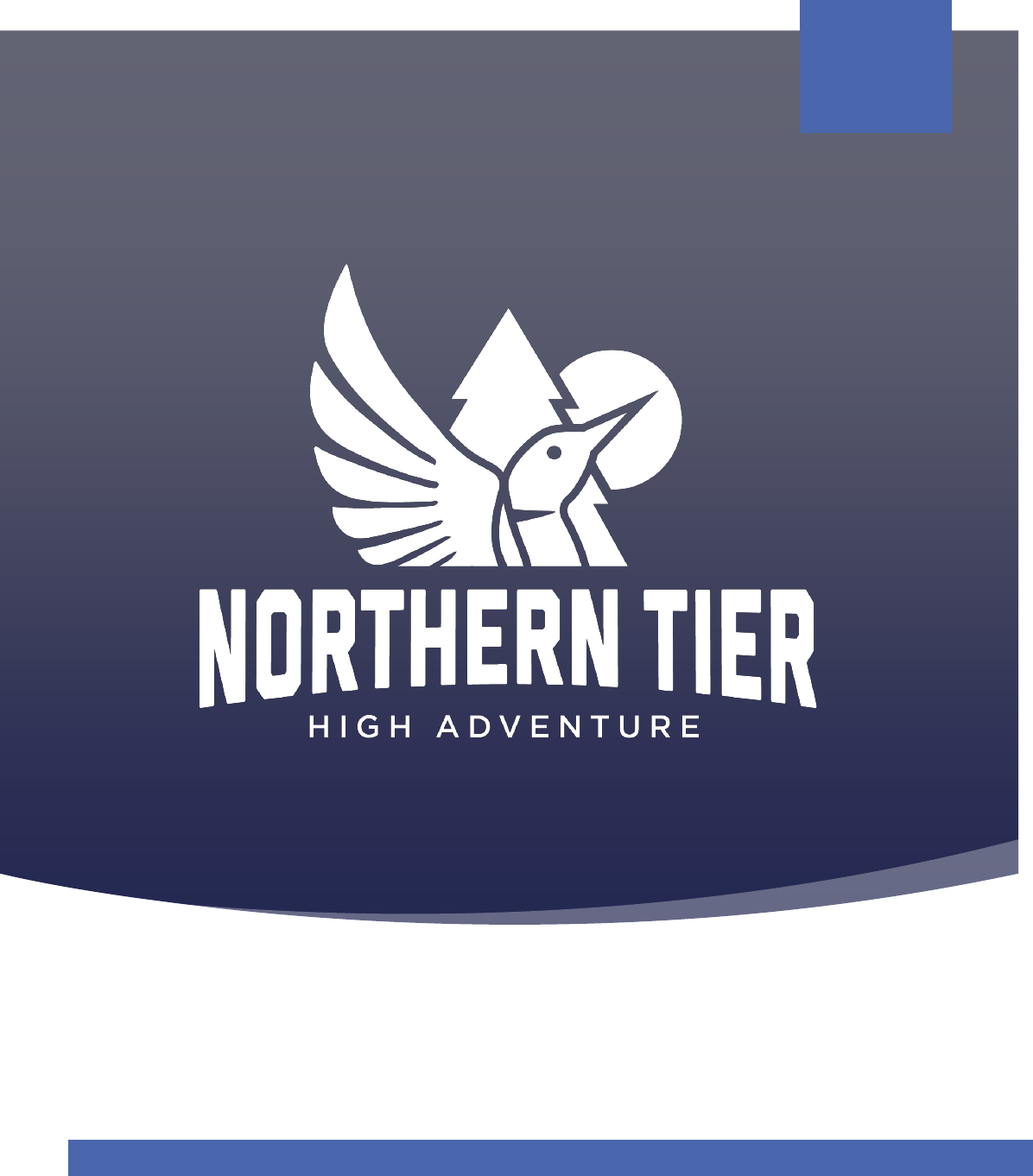
2023
ADVISOR’S PLANNING GUIDE
SUMMER WILDERNESS CANOE TRIPS

2023 Advisor’s Planning Guide Revised 11/8/22 Page 2
The way of a canoe is the way of the wilderness and of a freedom
almost forgotten. It is an antidote to insecurity, the open door to
waterways of ages past and a way of life with profound and abiding
satisfactions.
Sigurd Olson

2023 Advisor’s Planning Guide Revised 11/8/22 Page 3
CONTENTS
What are the requirements to attend? ......................................................................................................................... 6
Adult Leadership – BSA Policy................................................................................................................................ 6
Co-ed/Female Crew Policies .................................................................................................................................. 7
Northern Tier Crew Makeup Policies ..................................................................................................................... 7
Tenting Policies ...................................................................................................................................................... 7
How does a Northern Tier trip work?............................................................................................................................ 8
What are Northern Tier’s programs? ............................................................................................................................ 9
Second Season Opportunities- Ely, MN .......................................................................................................................11
What are the risks? (Risk Advisory) ............................................................................................................................12
Trip Planning Schedule ................................................................................................................................................13
18 Months Prior to Trip (December-March): .......................................................................................................13
14 Months Prior to Trip (April – August): .............................................................................................................13
9 Months Prior to Trip (September – December): ...............................................................................................13
6 Months Prior to Trip (January and February):...................................................................................................13
3 Months Prior to Trip (March – June): ................................................................................................................14
WHAT ARE THE FEES TO ATTEND? ..............................................................................................................................14
How do I make a reservation? .....................................................................................................................................14
What is the crew payment schedule and policy? ........................................................................................................15
How do I pay for my trip? ............................................................................................................................................15
What is included in my Northern Tier camping fees? .................................................................................................16
Fishing Licenses ...........................................................................................................................................................16
WHEN DO I PLAN MY ROUTE? .....................................................................................................................................17
Choosing a Park ...........................................................................................................................................................18
Permit Fees ..........................................................................................................................................................18
Additional Quetico Parks Information .................................................................................................................19
WHERE CAN WE STORE OUR ITEMS WHILE ON THE WATER? ....................................................................................20
WHERE DO WE SLEEP ON BASE? SHOWER? DO LAUNDRY? .......................................................................................20
HOW DO WE STAY IN TOUCH WITH OUR FAMILY AND FRIENDS WHILE WE’RE AT NOTHERN TIER? ........................20
WHAT IF THERE IS AN EMERGENCY WHILE ON THE TRAIL? ........................................................................................21
Parent/Legal Guardian Notification – In the case of injury or illness .........................................................................21
WHAT GEAR IS NEEDED? .............................................................................................................................................21
WHAT HAPPENS WHEN I ARRIVE AT BASE? ................................................................................................................21
Trading Post (retail store) ............................................................................................................................................22
WHAT ABOUT OUR FOOD? WHAT DO WE EAT? .........................................................................................................22
WHAT Participants with Special Diet Needs? ..............................................................................................................23
What is medical service like in the area? ....................................................................................................................23
Appendix and Important Documents ..........................................................................................................................24
APPENDIX A .................................................................................................................................................................25
NORTHERN TIER INDVIDUAL PROGRAMS ............................................................................................................25
APPENDIX B..................................................................................................................................................................27
Required Check-In Documents .............................................................................................................................27
APPENDIX C ..................................................................................................................................................................28

2023 Advisor’s Planning Guide Revised 11/8/22 Page 4
Recommended Physical Fitness Plan ...................................................................................................................28
APPENDIX D .................................................................................................................................................................29
Height and Weight Requirements ........................................................................................................................29
APPENDIX E ..................................................................................................................................................................30
NORTHERN TIER HIGH ADVENTURE BASES ..........................................................................................................30
APPENDIX F ..................................................................................................................................................................32
REQUIRED Personal Gear .....................................................................................................................................32
OPTIONAL Personal Gear .....................................................................................................................................33
REQUIRED Crew Gear ...........................................................................................................................................33
OPTIONAL Crew Gear ...........................................................................................................................................33
Appendix G ..................................................................................................................................................................34
Crew First Aid Kit ..................................................................................................................................................34
Appendix H ..................................................................................................................................................................35
Gear Provided by northern tier ............................................................................................................................35
APPENDIX I ...................................................................................................................................................................36
Northern Tier Policies ...........................................................................................................................................36
APPENDIX J ..................................................................................................................................................................38
Northern Tier Awards ...........................................................................................................................................38
APPENDIX K ..................................................................................................................................................................39
PARENTAL RELEASE FORM ...................................................................................................................................39
Appendix L – Arrival and Departure Information – ELY, MN.......................................................................................40
How do I get to the ely base? ..............................................................................................................................40
Transportation Options to Ely: ............................................................................................................................41
Appendix M – Arrival and Departure Information – atikokan, ON .............................................................................43
TRANSPORTATION OPTIONS to atikokan: ...........................................................................................................43
CROSSING THE CANDIAN BORDER ......................................................................................................................44
Where can I stay en route to the Atikokan base? ...............................................................................................45
Appendix N – Arrival and Departure Information & additional information – bissett, MB ........................................46
How do I reserve my Bissett crew’s float plane? ................................................................................................46
Arrival and Departure Information- bissett.........................................................................................................46
TRANSPORTATION OPTIONS to bissett: ..............................................................................................................47
CROSSING THE CANDIAN BORDER ......................................................................................................................48
2023 Advisor’s Planning Guide Revised 11/8/22 Page 5
WELCOME TO NORTHERN TIER…
Founded in 1923, Northern Tier is the oldest High Adventure Program in the Boy Scouts of America. For over 90
years, Scouts at Northern Tier have paddled pristine lakes, sweated over rugged portages and explored the
untrammeled wilderness of the Great North American Canoe Country.
Though there have been many changes since 1923 (wood-canvas canoes giving way to aluminum canoes giving way
to Kevlar canoes), the basic program of Northern Tier has remained the same. A massive wilderness area combined
with the expertise and leadership of a trained staff member (called an “Interpreter”) provide a challenging and
meaningful program for youth. The program is simple, and it works.
The goal of a Northern Tier canoe trip is to have each participant have a wilderness adventure that lasts a lifetime.
Through the experience of the rugged wilderness, Scouts learn physical fortitude and mental strength; through the
isolated interactions within their crew, Scouts learn lessons in leadership, in the importance of doing their share of
the work and in the necessity of teamwork to accomplish difficult tasks. Northern Tier facilitates this through a
youth led experience. Northern Tier provides all necessary crew gear, an emergency communication device and a
trained staff member to facilitate the experience. To insure a positive and safe trip that is focused on the further
development of Scouts, some methods we employ are: use of lifejackets while on water, single trip portaging, three
people to a canoe, use of boots while travelling in the wilderness and careful practice of Leave No Trace Wilderness
Ethics. Through the completion of their trip, Scouts gain confidence in their abilities to overcome tough challenges.

2023 Advisor’s Planning Guide Revised 11/8/22 Page 6
WHAT ARE THE REQUIREMENTS TO ATTEND?
All Northern Tier Participants:
• Must be 14 years of age or be 13 years of age and have completed 8
th
Grade upon arrival at Northern Tier.
• Must fall below the maximum (295 pounds) allowed weight for participation and it is strongly
recommended that no participant weigh less than 100 pounds. See Appendix D.
• Must have a current (within 12 months) and completed BSA Health and Medical Record. The doctor
completing the form must review the Northern Tier Risk Advisory included with the form. The Northern
Tier form can be found at https://www.scouting.org/health-and-safety/ahmr/
• Must be classified as a BSA swimmer, see appendix E.
• Must be a registered member of the Boy Scouts of America.
The Boy Scouts of America and Northern Tier takes Youth Protection very seriously. Some of the Youth Protection
policies that apply to participants at Northern Tier (and throughout Scouting) relate to registration and training.
The complete set of Youth Protection policies may be found at https://www.scouting.org/health-and-safety/gss/
Northern Tier will strictly enforce Youth Protection policies, which include the Barriers to Abuse within Scouting
All registered adults must have current BSA Youth Protection Training (certified within the past two years). This
means all participants 18 years old and older who are registered in Venturing, Exploring, Sea Scouting, or as an
adult volunteer must have current Youth Protection Training. Because of the great concern the Boy Scouts of
America has for the issue of child abuse in our society, the Youth Protection program has been developed to help
safeguard both our youth and adult members. Adult BSA Registration requires verification of Youth Protection
Training. All adults participating in a Northern Tier expedition must be registered. Youth Protection Training and
documentation are available at your local council or online at https://www.scouting.org/training/youth-
protection/.
ADULT LEADERSHIP – BSA POLICY
• As shown above, each crew MUST always have at least TWO BSA registered adults (called “Advisors”) age
21 or older.
• All adult participants are required to present proof of BSA Youth Protection training upon arrival at
Northern Tier. At least one adult in each crew must have proof of current CPR, Wilderness First Aid and
Weather Hazards training. Northern Tier also recommends at least one adult complete BSA paddle Craft
Safety training.
Age
BSA/Youth Protection Policies
Under
18
• Must be registered in a Youth position
18-21
• Must be current in Youth Protection training
• Must be registered in an Adult position
21+
• At least two Registered leaders are required
• A Registered female adult leader 21 years of age or over must be present
for any activity involving female youth
• All leaders must be current in Youth Protection training
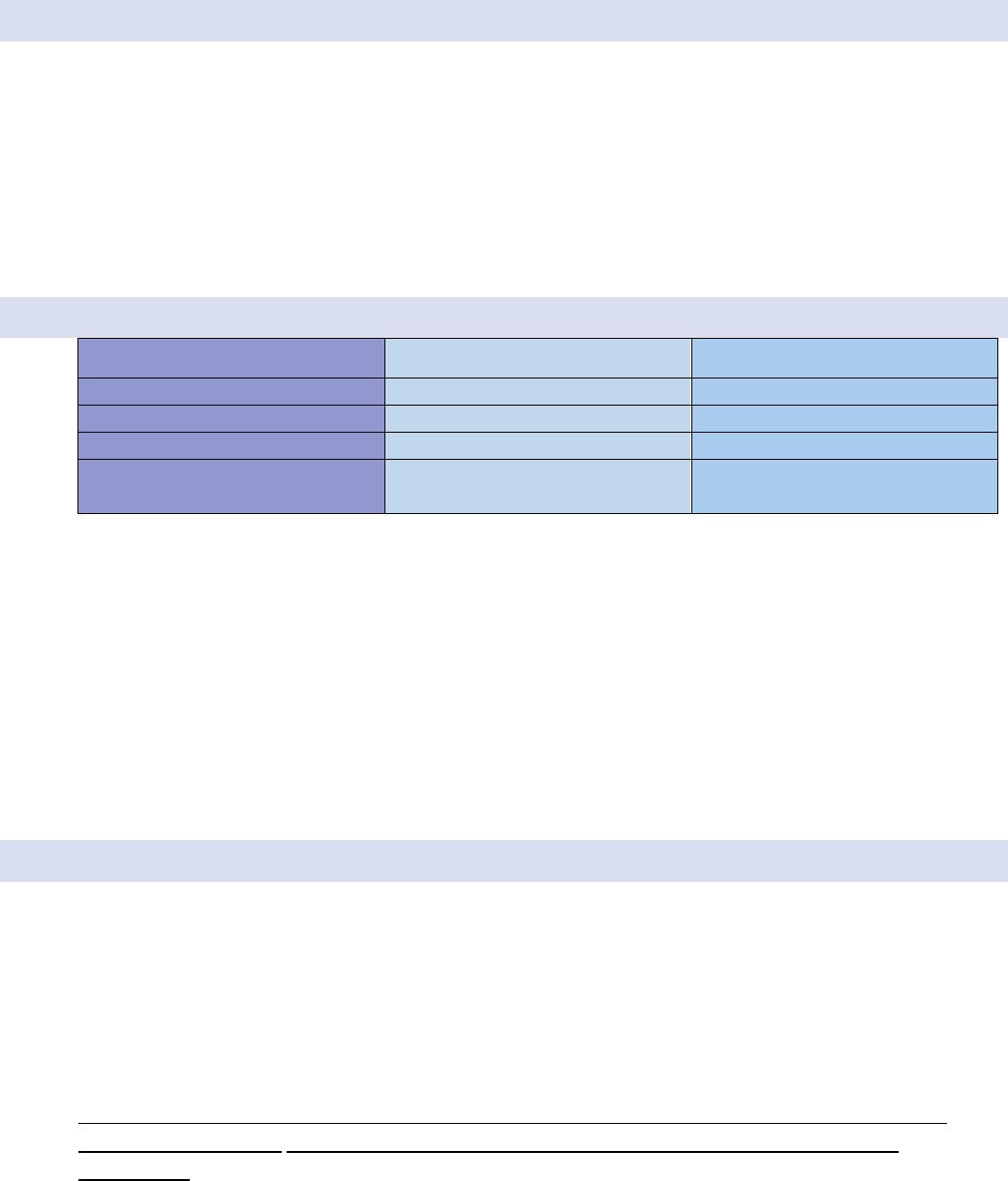
2023 Advisor’s Planning Guide Revised 11/8/22 Page 7
CO-ED/FEMALE CREW POLICIES
• Crews with coed youth members must function under appropriate co-ed unit policies.
• Scouts BSA Troops: Scouts BSA is a single gender program and units must register and paricipate as
single-gender units.
• Venuring Crews: The venturing program is a co-ed program and units may register and participate as a
co-ed crew. All youth must have a buddy of the same gender on the crew.
Crews with female youth are required to provide two adults age 21 and over, at least one of those adults
must be a female Advisor. A female adult is required, even if female youth’s father is in attendance.
NORTHERN TIER CREW MAKEUP POLICIES
Ely, MN Canoe Programs
Atikokan, ON Canoe Programs
Bissett, MB Canoe Programs
Max crew size is 8 participants
Max crew size is 11 participants
Max crew size is 11 participants
Min crew size is 6 participants
Min crew size is 6 participants
Min crew size is 6 participants
Min 2 registered adults age 21+
Min 2 registered adults age 21+
Min 2 registered adults age 21+
Crew must be majority youth
age 14-18
Crew must be majority youth
age 14-18
Crew must be majority youth
age 14-18
Youth Participants:
• Must be at least 14 years old OR have completed the 8
th
grade and be at least 13 years old prior to
participation.
• Must be registered members of the Boy Scouts of America and may participate in a Northern Tier trek in
one of the following ways:
✓ As members of a chartered unit—Troop, Crew, Post, or Ship.
✓ As members of a council contingent or district contingent with required leadership.
✓ As individuals in Northern Tier’s individual programs.
• Each participant must meet the health requirements as outlined in the BSA Annual Health and Medical
Record.
TENTING POLICIES
Tenting arrangements at Northern Tier follow BSA's tenting requirements
(https://www.scouting.org/health-and-safety/gss/) and must meet the requirements shown below:
• Separate tenting arrangements must be provided for male and female adults as well as for male and
female youth
• Youth (14-17) cannot share tents with anyone 18 or older (including parent)
• Youth under 18 may share tents only if no more than 2 years age difference
• Spouses may share tents
• Unregistered guests or family members are NOT permitted to camp at Northern Tier. There are no
scheduled programs or available housing accommodations for family members of expedition
participants.
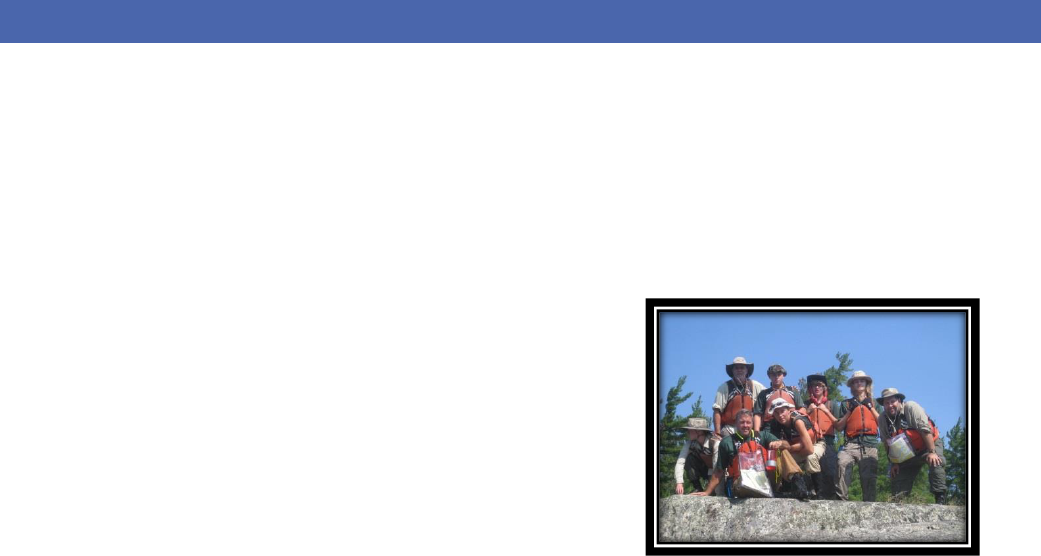
2023 Advisor’s Planning Guide Revised 11/8/22 Page 8
HOW DOES A NORTHERN TIER TRIP WORK?
The Crew
All Northern Tier participants belong to a crew. Crews vary in size (at the Ely Base they are limited to 8 people; at
the Canadian bases they are limited to 11 people), but all crews consist of at least two adult leaders, a youth crew
leader and a majority of youth participants. A Northern Tier Interpreter accompanies all crews.
Larger troops will be divided into “sister” crews. Though sister crews may know each other, they will have
independent experiences while at Northern Tier to maintain the integrity of the wilderness program. Sister crews
will not see each other in the wilderness.
The Crew Leader
The Program of the Boy Scouts of America is specifically designed to
develop youth leadership. A well-qualified Scout or Venturer should
be selected as the Crew Leader early in the planning of each
Northern Tier Expedition. The Crew Leader is responsible for leading
the discussion of the Crew’s route selection, organizing the pace of
travel during the day and establishing the Crew duty roster for camp
chores.
The Advisor
The Crew Advisor serves as a counselor and coach to the Crew Leader. The Crew Advisor is also responsible for
ensuring the safety of everyone in the crew: all Crews are required to have an adult with training in Wilderness
First Aid and CPR. Finally, the Crew Advisor addresses crew conflicts that may require appropriate discipline.
The Interpreter
The Interpreter is a Canoe Country Counselor who serves as a teacher and resource for the Crew Leader and
Crew. The Interpreter has received special training in the best practices for canoe country travel. The Interpreter
aids the Crew Advisor in ensuring the safety of the crew. Finally, the Interpreter is responsible for imparting the
unique flavor, history, culture and adventurous spirit of the North Country to the crew. The Interpreter works with
the crew to ensure an outstanding experience for everyone. They will provide ongoing evaluation of camping and
canoeing skills and coach members toward success.
The Wilderness
Northern Tier crews paddle through massive wilderness areas, where solitude allows for deeper meditation and
the rugged terrain and mercurial elements provide for physical challenge. The wilderness is part-classroom and
part-instructor in the Northern Tier experience.
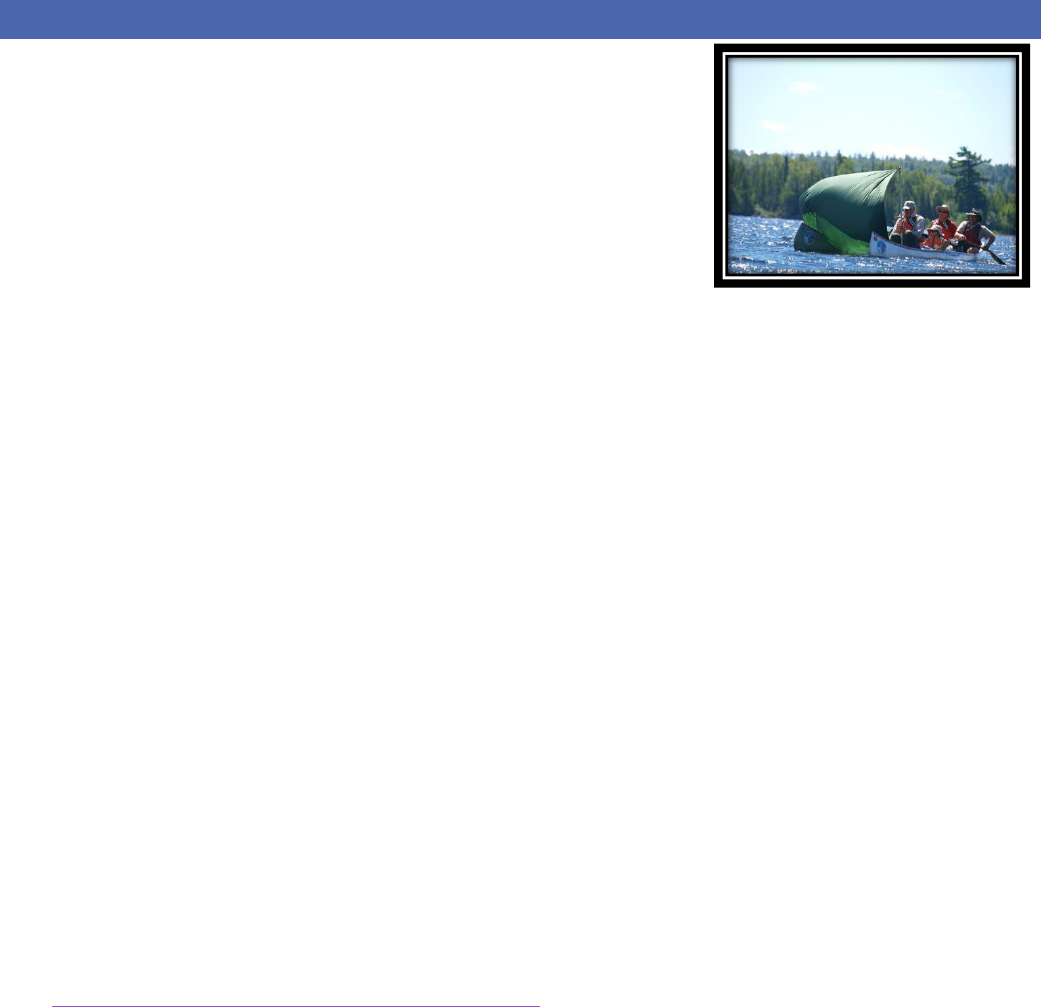
2023 Advisor’s Planning Guide Revised 11/8/22 Page 9
WHAT ARE NORTHERN TIER’S PROGRAMS?
Northern Tier consists of three Wilderness Canoe Bases located in Ely,
Minnesota; Atikokan, Ontario; and Bissett, Manitoba. Each base has its own
personality and specific characteristics that make it more appealing to
certain crews. In addition, certain bases have specialty programs that may
be of interest to your Scouts.
Ely, Minnesota (Charles L. Sommers Canoe Base)
Northern Tier’s oldest base, the Ely base outfits over 4,000 participants
every year for wilderness canoeing. Northern Tier has hosted trips out of the Ely base since 1941.
Located outside of Ely, MN, crews leaving from the base can choose to paddle the Boundary Waters Canoe Area
Wilderness (BWCAW) in Minnesota or cross the border (only a 6-mile paddle away) into the southern portion of
Ontario’s Quetico Provincial Park. Crew size is limited to 8-people at the Ely Base.
Wilderness usage is strictly limited by a permitting system that allows only so many groups to enter the
wilderness at any given point each day. It is likely to see other groups if a crew chooses to stay closer to the entry
point; however the expeditious crew may get away from all contact with others by planning a longer route.
Boundary Waters Canoe Area Wilderness
Nestled in the Superior National Forest in Northern Minnesota, the BWCAW – at 1.1 million acres – is
the largest federally designated wilderness area in the contiguous United States. Extending nearly 150
miles along the Ontario Border, the BWCAW is known worldwide as a premier wilderness canoeing
destination with over 250,000 visitors every year. Camping is restricted to designated campsites which
contain a US Forest Service fire grate and a pit toilet.
Quetico Provincial Park – Crews from Ely
Quetico Provincial Park is the superlative canoe-expedition wilderness. Almost all human traces have
been removed, crews are allowed to camp anywhere they choose. The park’s 1.2 million acres include
over 600 lakes with well over 2,000 remote campsites. Quetico is considered the finest canoe park in the
world. Paddling Quetico requires a permit (Permit cost is set by Ontario Parks and may change prior to
your arrival. Crews should budget at least $1,000 for permit fees if planning to paddle in the Quetico.
For more detailed information about Quetico visit
https://www.ontarioparks.com/park/quetico/camping
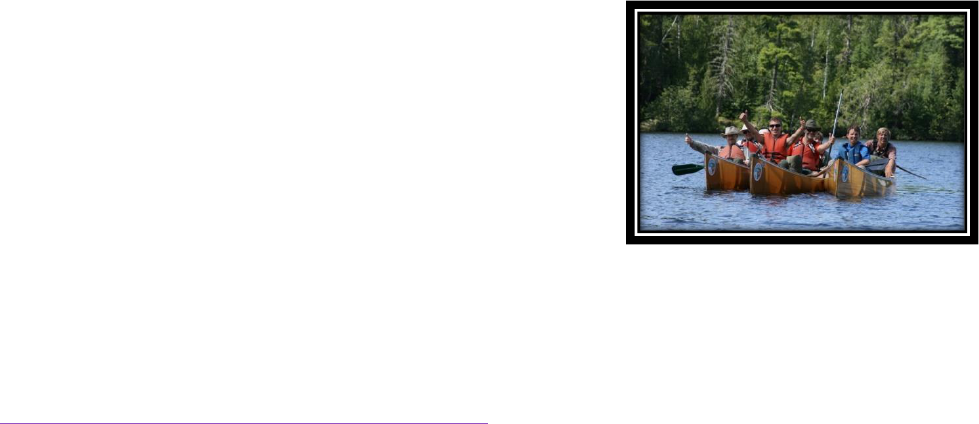
2023 Advisor’s Planning Guide Revised 11/8/22 Page 10
Atikokan, Ontario (Don Rogert Canoe Base)
Located on beautiful Perch Lake outside of the community of Atikokan,
Ontario. Atikokan base outfits over 1500 participants every summer.
Crews at the base paddle in two distinct regions, the Quetico Provincial
Park and the Canadian Crown Lands (part of which is the Turtle River –
White Otter Provincial Park).
Quetico Provincial Park- Crews from Atikokan
Quetico Provincial Park is the superlative canoe-expedition
wilderness. Almost all human traces have been removed, crews are allowed to camp anywhere they
choose. The park’s 1.2 million acres include over 600 lakes with well over 2,000 remote campsites.
Quetico is considered the finest canoe park in the world. Paddling Quetico requires a permit (Permit
cost is set by Ontario Parks and may change prior to your arrival. Crews should budget at least $1,000
for permit fees if planning to paddle in the Quetico. For more detailed information about Quetico visit
https://www.ontarioparks.com/park/quetico/camping
Crownlands
Crews paddling in the Crown Lands can expect to find old trappers cabins, abandoned gold mines, and
rotting logging sluices in addition to a gorgeous wilderness area. Roughly equivalent to National Forest
or Bureau of Land Management regions in the United States, the Canadian Crown Lands are designed
for multiple users: logging, mining, and tourism all coexist in the massive area of land owned and leased
by the Canadian government (89% of Canada are the Crown Lands). A rich human history coexists within
a wonderful natural area. No permits are needed for the Crown Lands; crews are limited to 11 or less
participants.
Base to Base Trips (Ely to Atikokan or Atikokan to Ely)
Particularly adventurous crews can choose to paddle across the entirety of Quetico from the Ely Base in
Minnesota to the Atikokan Base in Ontario or vice versa. These trips range between 90 and 150 miles (9-day or
longer trip length is required), include crossing the US-Canadian border remotely, and feature some of the best
wilderness paddling around.
This is one of the coolest trips out there, but there are a few more logistical issues to resolve. Typically, base to
base crews will have a sister crew doing a trip in the opposite direction, each crew leaves a car at the base they
started from, allowing for a simple departure. Northern Tier does not provide shuttling services for base-to-base
crews. If you are interested in this type of trip, contact Northern Tier as soon as possible.

2023 Advisor’s Planning Guide Revised 11/8/22 Page 11
Bissett, Manitoba (Northern Expeditions Canoe Base)
The most remote High Adventure opportunity in the Boy Scouts of America,
the Bissett Base offers an unparalleled wilderness adventure opportunity for
those Scouts who desire a greater challenge.
All trips begin and end with a float plane trip to a canoe cache that Northern
Tier maintains in the heart of the 1.5 million acre Atikaki Provincial Park. The
500-600 Northern Tier participants that use the park every year form the
majority of users for the area – the region is very wild and very beautiful,
and the fishing is excellent.
Bissett crews are typically older and have prior High Adventure experience.
The area is very remote and travel can be quite strenuous – if you find these facts exciting, you may be well suited
for a trip through Bissett.
SECOND SEASON OPPORTUNITIES- ELY, MN
Autumn Adventures
A plethora of opportunities are available for adventures in the fall. Northern Tier has a very flexible fall program
that can be customized to fit a crew’s desire. If you have a crew interested in an autumn adventure, please
contact Northern Tier.
Okpik Cold Weather Camping
Northern Tier’s OKPIK Cold Weather Camping Program is one of the most unique programs in scouting. OKPIK
runs from December 18 through the first weekend in March. Details on the OKIPK program are available at
ntier.org.
Training Center and Conferences
Northern Tier hosts training events throughout the year: Leave No Trace Master Educator, Wilderness First
Responder, Cold Weather Leader Training, Wilderness First Aid, etc. In addition, Northern Tier facilities are
available for conference use throughout the fall.

2023 Advisor’s Planning Guide Revised 11/8/22 Page 12
WHAT ARE THE RISKS? (RISK ADVISORY)
Northern Tier National High Adventure Programs have an outstanding safety record. The Boy Scouts of America
and Northern Tier emphasize safety through education and strict adherence to established policies and
procedures. The safety of your group is dependent upon your attention to these procedures as well as being
physically fit, properly equipped and trained for the rigors of remote wilderness canoeing.
The policies and procedures of Northern Tier and the Boy Scouts of America, if followed, will minimize these risks
as much as possible. Parents, leaders and participants should be advised that despite our best attempts at risk
management, it is not possible to remove ALL risk from a wilderness expedition.
Possible risks include (but are not limited to) motor vehicle accidents; severe weather conditions such as hail,
lightning, heat or cold and high winds; forest fires; medical conditions such as heart attack, appendicitis,
hypothermia, severe allergies and asthma or diabetes related conditions; insect borne diseases such as the West
Nile Virus and Lyme Disease; accidents such as cuts, embedded fish hooks, burns or falls; risks associated with
being on large, cold lakes; and encounters with wildlife.
Medical evacuations and rescue services are coordinated by Northern Tier in close coordination with local
authorities.
Please carefully read the information in this Planning Guide and share it with your crew(s), leaders, parents and
youth. If you have any further questions about risk management, contact Northern Tier by phone 218.365.4811 or
e-mail at info@ntier.org.
Other General Information:
Insurance
Northern Tier fees include accident and sickness insurance coverage. This applies for your travel to and from the
Northern Tier, as well as your Northern Tier Expedition. This policy is secondary to a family policy. All participants
with family insurance should include the insurance company name and policy number on their BSA Health and
Medical Record form and should also submit a copy of the insurance card with the medical form.
Northern Tier strongly recommends you purchase trip insurance to aid in covering in travel related losses due to
cancellations, illness or other potential issues.

2023 Advisor’s Planning Guide Revised 11/8/22 Page 13
TRIP PLANNING SCHEDULE
18 MONTHS PRIOR TO TRIP (DECEMBER-MARCH):
• Northern Tier opens registration early January for crews making reservation for the following year. For
example, a crew wishing to reserve a trip for summer of 2024 would make a reservation in January of
2023. Start planning your trip prior to this date so that you can make a reservation as soon as possible.
• A $250 deposit is due at the time of reservation and an additional 10% of the balance is due within 30
days.
• You will need to recruit individuals to attend your trek (if you have not done so already). It is
recommended having a few more individuals recruited than needed so that you can continue to maintain
full crews as individuals drop out.
• We have promotional material available for download at http://www.ntier.org/Resources
• You will then need to collect a deposit from these individuals to secure your spot.
• Arrange to complete your required Adult Leader Trainings and Certifications.
14 MONTHS PRIOR TO TRIP (APRIL – AUGUST):
• Start training for your Northern Tier Expedition – make sure that the other members of your crew are
training as well. Training should include:
• Engaging in physical activity for at least 30 minutes 5 days each week
• Develop basic camping skills: cooking, building fires, pitching a tent and hanging a bear bag.
• Canoeing and Backpacking: learn the J-Stroke, carry a 50-lb Pack, and portage a Canoe.
• Please see Appendix C for a sample fitness program.
• Begin arranging your travel to and from Northern Tier: flights, ground transportation to and from the base
and any lodging while traveling. More information on travel options can be found in this document or at
www.ntier.org/TripPlanning.
9 MONTHS PRIOR TO TRIP (SEPTEMBER – DECEMBER):
• Collect funds for your third payment. This payment is due October 1. Make sure to update Northern Tier
of any changes to your number of crews, and your participation numbers prior to October 1st.
• Make sure your crew sets up Doctor Appointments to update their BSA Health and Medical Records.
These Records must be current within a year of your trip. Make sure all members of your crew meet the
physical requirements to participate in a Northern Tier trip, including the Height and Weight
Requirements found in Appendix D.
• Northern Tier sends information on the different types of parks and routes to paddle through in the fall.
Use this information to fill out your Permit Application. The Permit Application is due on December 1.
• Begin reviewing the personal equipment list with your crew. Gear items make great Christmas gifts and
can be purchased in our trading post online at store.ntier.org.
• Complete campership applications. Campership applications are due by January 31
st
.
6 MONTHS PRIOR TO TRIP (JANUARY AND FEBRUARY):
• Crews traveling in the Boundary Waters Canoe Area Wilderness and Quetico Provincial Park should expect
reservation confirmation e-mails in January, February and March. If you have not received your
reservation confirmation by February, please contact the Northern Tier Registrar.
• Campership applications are due by January 31
st
.
• Ely Quetico Crews submit your RABC applications to Canadian Border Service Agency.
• Check Passport Expiration and/or apply for Passports if traveling in Canada.

2023 Advisor’s Planning Guide Revised 11/8/22 Page 14
3 MONTHS PRIOR TO TRIP (MARCH – JUNE):
• Keep your eyes peeled for a Spring Update with last minute planning details. Please review materials with
your crew members.
• Final Payments are due on April 1.
• Double check that all of your check in paperwork is together (see appendix B).
• Complete and Submit your Crew Roster.
• Double Check that all Certifications (WFA, CPR and BSA E-Certifications) are complete
• Double Check that all participants have current BSA Health and Medical Records
• Make sure that you have a completed BSA Swim Test for all participants (See appendix E)
• Pack a full and thorough First Aid Kit to take with you on your trek. (See appendix G)
• Finalize all Transportation Plans. If you have any questions, please contact Northern Tier!
• Bissett crews make sure your Float Plane is reserved.
• Atikokan crews traveling through the crownlands, route selections are due with final payment.
• Notify Northern Tier of any special diet needs by utilizing the appropriate form in events.scouting.org,
when completing your rosters. Further instructions will be available in the spring of your participation
year.
o Please keep in mind that while we try to be as accommodating as possible, we will not be able to
accommodate all food needs and may ask participants with certain needs to supplement the
menu with their own food.
o Indivdiuals requiring special diet food, will be assessed a $75 charge. Individuals are welcome to
bring their own, keep in mind it must all be prepackaged and shelf stable. No fresh foods.
WHAT ARE THE FEES TO ATTEND?
Updated Northern Tier fees can be found on the Northern Tier website on the registration page:
ntier.org/register
• Northern Tier fees are all inclusive of charges you will incur when attending Northern Tier, except:
o Crews choosing to travel in Quetico Provincial Park, will pay additional Park Permit Fees. Those
fees are paid at the time you enter the park at the beginning of your expedition.
o Bissett Crews will make and pay for their float plan registration separately.
HOW DO I MAKE A RESERVATION?
You are ready to book your trip when the following questions have been answered:
1. Which base do we want to attend? Ely? Atikokan? Bissett? See pg. 9 for more information on the bases.
2. What day do we want to arrive? Crews can arrive any day between June 5 and August 20
th
, a list of
available sessions is located at ntier.org/register.
3. How long of a trip do we want? Detailed information on trip length by base is available on the Northern
Tier website. Trips vary in length from 7-nights to 11-nights.
4. How many crews will we need?
a. Ely crew size: 6-8 participants
b. Atikokan and Bissett crew size: 6-8 participants or 9-11 participants.
5. Do you know your BSA membership ID number? You will need this number to make your reservation.
Once you have answered all of the above questions, visit www.ntier.org to make your reservation or call Northern
Tier 218-365-4811.
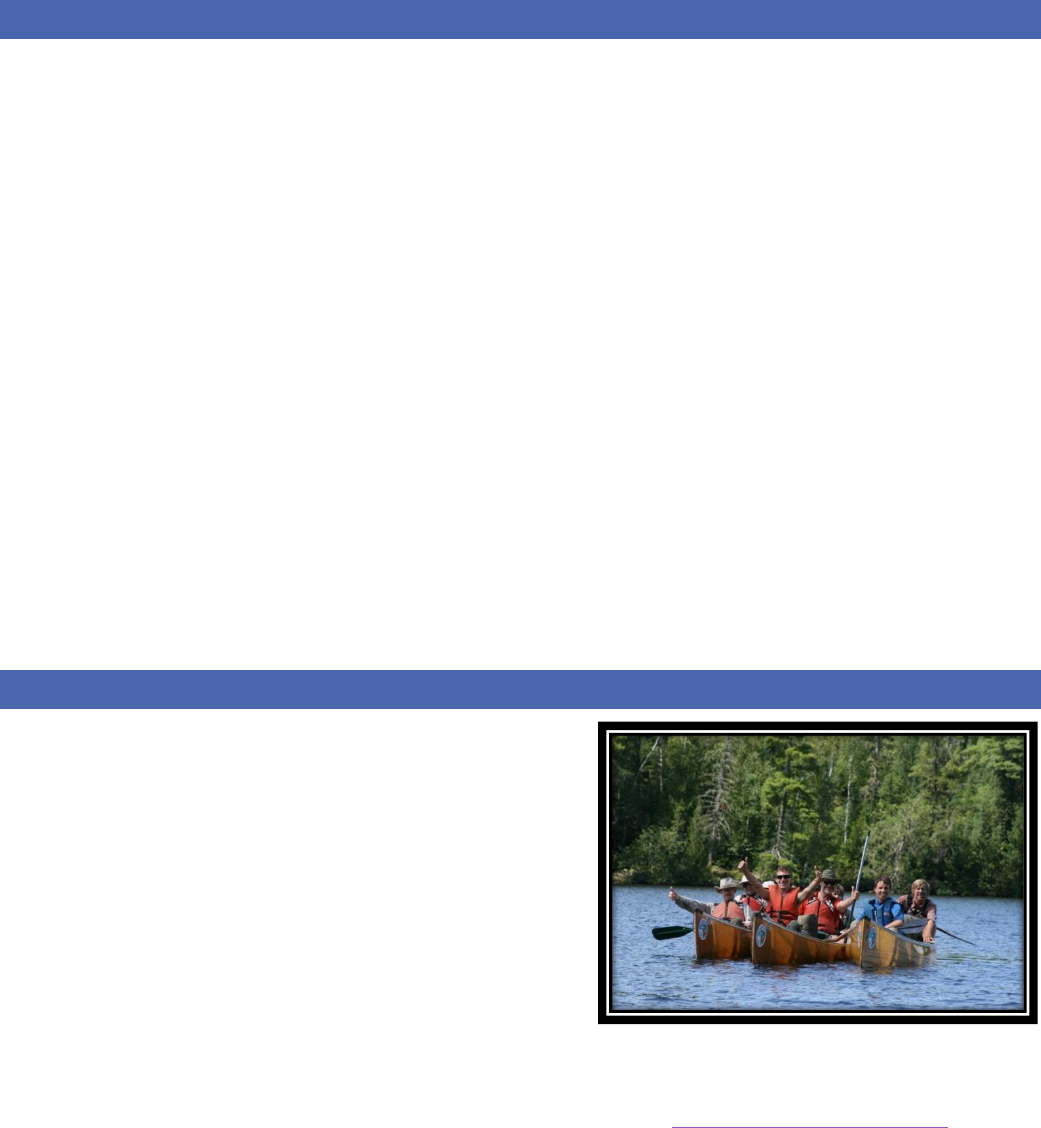
2023 Advisor’s Planning Guide Revised 11/8/22 Page 15
WHAT IS THE CREW PAYMENT SCHEDULE AND POLICY?
Summer Payment Schedule
1. $250.00 Deposit due upon registration to secure your adventure.
2. 10% of remaining fees due 30 days following registration.
3. 50% of remaining fees due October 1
st
of the year prior to your arrival
4. Final Payment – Balance due April 1
st
.
All fees (deposit, first payment and final payment) are non-refundable and non-transferable in event of
cancellation. Exercise caution in making reservations or paying fees for anyone who has not made a financial
commitment. Northern Tier High Adventure Programs must commit financial resources to employ staff, purchase
food and supplies, and prepare for base operations. Participants are, therefore, also required to make a financial
commitment to attend. Be conservative in making reservations to avoid losing fees due to cancellations.
What is My Crew Number?
In your confirmation email, you will be given a crew number. This number should be referenced in any
correspondence with Northern Tier. Your crew number is assigned to you based upon which base you are
attending, the date you are arriving and the number of crews that you have.
For example crew number ET061123-ABC is compiled of:
• E represents the base you are attending:
o E is for Ely, A is for Atikokan, B is for Bissett
• T represents 10 nights
o T is for 10 nights, E is for 8 nights, S is for Seven nights
• ‘061123’ is the date this crew will arrive at Northern Tier (June 11, 2023)
• ABC indicates that this group consists of 3 crews: Crew A, Crew B and Crew C
HOW DO I PAY FOR MY TRIP?
Payments can be made by check or ECheck (ACH). When your
registration is completed, you will be able to access your
registration anytime online to make future payments. If you
prefer to send a check, please make checks out to Northern
Tier, BSA. Include your expedition number or reservation
number on the memo line of the check. Send to:
Northern Tier National High Adventure
Attn: Registrar
PO BOX 509
Ely, MN 55731
Camperships
Camperships are available to youth members with special financial needs who are participating in the Northern
Tier program. The campership application can be found on our website at ntier.org/resources/parentinfo. The
completed required documents must be returned to Northern Tier by January 31 of the year your crew attends.
The camperships will be reviewed in February with notification going to the crew advisor prior to the due date of
the final crew payment.
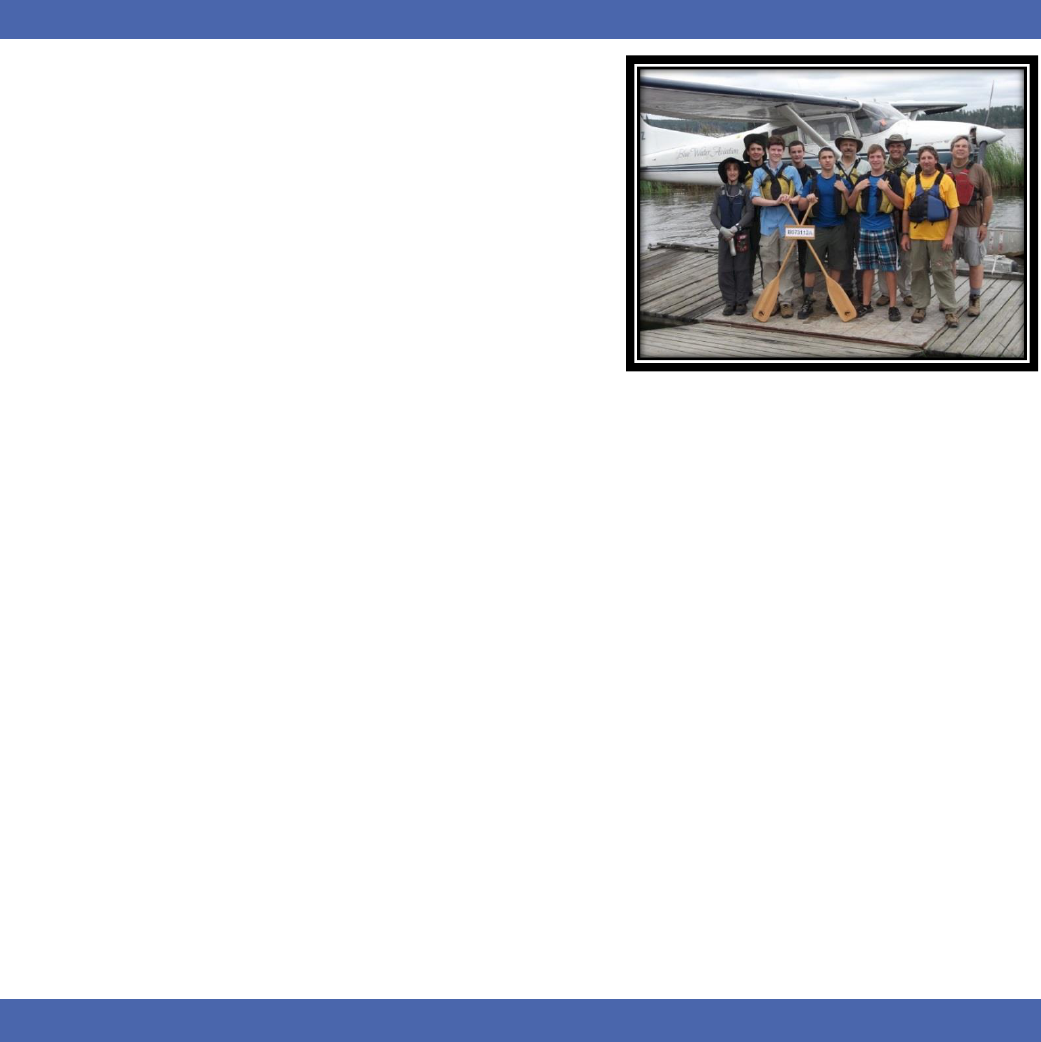
2023 Advisor’s Planning Guide Revised 11/8/22 Page 16
WHAT IS INCLUDED IN MY NORTHERN TIER CAMPING FEES?
• Group Gear - Over $5,000 in trail equipment is issued to
your crew: stoves, tents, rain fly, cook set, packs, and
more.
• All Food while on the trail and two nights on base.
• Lodging the night you arrive and the night before you
leave.
• Canoes, paddles and lifejackets.
• Trained Staff Member (Interpreter) who will accompany
you for your entire trip.
• Emergency communications device (radio or satellite
phone)
• Special Participant Emblem
• Camper’s Accident Insurance
• Please note fees will be assessed for any loss or damages incurred while on your trip.
Other Costs of Northern Tier Trips:
• MAPS: Northern Tier requires that a set of Maps be carried in each canoe. In Ely, maps cost
approximately $8.00 and an estimated 2-4 maps are needed for each canoe. In Canada, maps cost
approximately $15.00 and an estimated 2-4 maps are needed for each canoe. Map cases are also
recommended for each set of maps and cost approximately $17.00 each.
• FLOAT PLANES: A Float Plane Shuttle is required at the Bissett Base. While the cost of a Float Plane will
not be announced until January, $275 CND/Person would be a good budgetary guess. Crews are
responsible for paying for their Interpreter’s Float Plane ride.
• CREW PHOTOGRAPHS: When you arrive at Northern Tier each crew has a photograph taken. You can
order copies of pictures by visiting photos.ntier.org
• PERMITS: Additional costs are required for crews travelling in Quetico Provincial Park. Please see your
base planning guide for more details.
• LOST AND DAMAGED GEAR: Crews will be responsible for any fees assessed for loss or damages incurred
while on your trip.
• FISHING LICENSES: Fishing licenses are required to fish at any of the bases.
• SPECIAL DIET FEES: Individual requesting a special diet will be charged an additional $75. Our food
service staff will confirm the needs can be met with you prior to assessing the fee.
FISHING LICENSES
Fishing Licenses should be purchased online in advance of your trip. Northern Tier does not have the ability to sell
you a fishing license. If youth under the age of 16 (for fishing in Minnesota) or under the age of 18 (for fishing in
Ontario) would like to fish, they can fish under the license of a single adult. However, their catch will be restricted
to this adult’s limit.
MINNESOTA FISHING LICENSES (BWCAW Crews)- All individuals, 16 years of age and older need to obtain a
license to fish in the Boundary Waters Canoe Area Wilderness (BWCAW), licenses can be purchased in advance
over the phone by calling 1-888-665-4236, or online. For current pricing and license information visit
http://www.dnr.state.mn.us/ NOTE: Regulations in Minnesota may be different than what you are used to at
home. Make sure to review these regulations when you purchase your license.
ONTARIO FISHING LICENSES (Quetico or Atikokan Crews) - All individuals 18 years of age and older need to
obtain a fishing license and Outdoors Card to fish in Ontario. These should be purchased over the phone at 1-800-
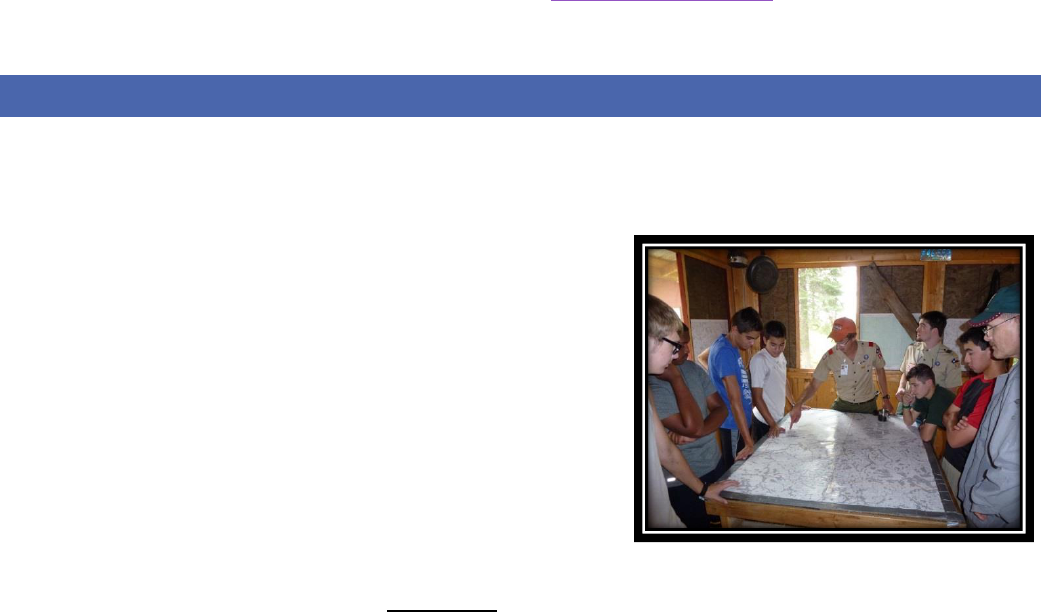
2023 Advisor’s Planning Guide Revised 11/8/22 Page 17
288-1155 or online at http://www.mnr.gov.on.ca/. NOTE: There are several regulations in Canada that may be
different than what you are used to in the US. Make sure to review these regulations when you purchase your
license.
MANITOBA FISHING LICENSES (Bissett Crews) – All individuals 16 years of age or older need to obtain a license to
fish in Manitoba. Crews are encouraged to pre-purchase a license through paper application well in advance of their
trip (2 months). Licenses can be bought in Manitoba from private vendors but are not sold at the Bissett base. For
more information, visit the Manitoba Conservation website: https://www.gov.mb.ca/.
WHEN DO I PLAN MY ROUTE?
Northern Tier expeditions traverse nearly 6 million acres of wilderness where contiguous lakes, rivers, streams
and portages offer some of the best canoeing and fishing country to be found in the world.
Ely, Bissett and Atikokan Quetico Crews- Months prior to your
arrival, you booked a permit for your trip. Once arriving at
Northern Tier, your Interpreter will help your crew plan a route
that best meets their overall needs, desires, hopes and dreams. In
fact, one of the most beautiful aspects of Northern Tier trips is that
your crew has complete control over what your route will be. Easy,
difficult, short, long, remote or staying close to base are all
possibilities and they are endless. As the wilderness areas in which
we paddle are ever changing due to weather, fires and human
intervention, we have no set routes that must be adhered to.
Rather our Interpreters are trained in how to select destinations
and loops in the wilderness and are knowledgeable about current
route conditions.
If your Atikokan crew is travelling into the Crown lands, you selected a general route prior to the final payment.
When you arrive, you will work with your interpreter to plan the day to day specifics from this selection.
To sum it up, your crew should arrive with answers to certain questions to enable your Interpreter to best be able
to help you plan your route.
• How many days is our trip?
• How far do we want to paddle each day?
o The average crew paddles/portages approximately 2 to 3 mph
o Easy days will encompass 8 to 12 miles
o Moderate days will be 13 to 19 miles
o Difficult days will be 20 miles and above
• Do we want to have a layover day (stay in a campsite 2 nights and a full day)?
• Do we want to fish a lot?
• Which of Northern Tier’s special awards do we want to earn?
o Which one(s)? What’s the priority?
• Do we want to try to avoid portages or embrace their amazing existence and challenge ourselves to
overcome as many as possible?
• Do we want to go on big lakes, small lakes, rivers or a combination?
• Do we want to see waterfalls?
• Do we want to see pictographs/petroglyphs?
• Do we want to really get away from others?

2023 Advisor’s Planning Guide Revised 11/8/22 Page 18
CHOOSING A PARK
Each crew travelling through the Ely, MN base or the Atikokan, ON base, will need to choose a park prior to your
trip. Permits are required at both of these bases. Northern Tier will book your permit for you, but additional
steps must be taken to provide that permit information.
You will receive an email from Northern Tier in late October in the year before your trip. This email will provide
complete instructions for requesting your permit. Northern Tier will book all permits, but additional information
is needed to do so. All permits for both BWCAW and Quetico are booked on a first come, first served basis and
are time sensitive. It is important to follow the instructions provided in the email your receive and complete all
steps prior to the deadline. Northern Tier cannot guarantee permits, if information is not accurate and received
prior to the booking dates.
Boundary Water Canoe Area Wilderness: Nestled in the Superior National Forest in Northern
Minnesota, the BWCAW – at 1.1 million acres – is the largest federally designated wilderness area in the
contiguous United States. Extending nearly 150 miles along the Ontario Border, the BWCAW is known
worldwide as a premier wilderness canoeing destination with over 250,000 visitors every year. Camping
is restricted to designated campsites which contain a US Forest Service fire grate and a pit toilet.
o BWCAW permits are available for Ely Crews Only
Quetico Provincial Park: is the superlative canoe-expedition wilderness. Almost all human traces
have been removed, crews are allowed to camp anywhere they choose. The park’s 1.2 million acres
include over 600 lakes with well over 2,000 remote campsites. Quetico is considered the finest canoe
park in the world. Paddling Quetico requires a permit (Permit cost is set by Ontario Parks and may
change prior to your arrival. Crews should budget about $1,000 for permit fees if planning to paddle in
the Quetico. For more detailed information about Quetico visit
https://www.ontarioparks.com/park/quetico/camping
o Quetico permits are available for Ely and Atikokan Crews Only
Canadian Crownlands: Crews paddling in the Crown Lands can expect to find old trappers cabins,
abandoned gold mines, and rotting logging sluices in addition to a gorgeous wilderness area. Roughly
equivalent to National Forest or Bureau of Land Management regions in the United States, the Canadian
Crown Lands are designed for multiple users: logging, mining, and tourism all coexist in the massive area
of land owned and leased by the Canadian government (89% of Canada are the Crown Lands). A rich
human history coexists within a wonderful natural area. No permits are needed for the Crown Lands;
crews are limited to 11 or less participants. In the spring before arrival the Crownlands Route Selection
book will be made available for your crew to select their route.
o Canadian Crownlands are available for Atikokan Crews Only.
PERMIT FEES
BOUNDARY WATERS CANOE AREA WILDERNESS (BWCAW) FEES
All crews at the Ely base who will be staying in the United States will need a BWCAW Permit. All BWCAW Fees are
included in the cost of your trip. Any permit change or cancellation fees will be assessed to the crew.
QUETICO PROVINCIAL PARK FEES
Northern Tier will reserve your Quetico permit for you. The initial permit deposit is included in your total fees for
Northern Tier. The remainder of your Quetico fees will be paid to Quetico Provincial Park:
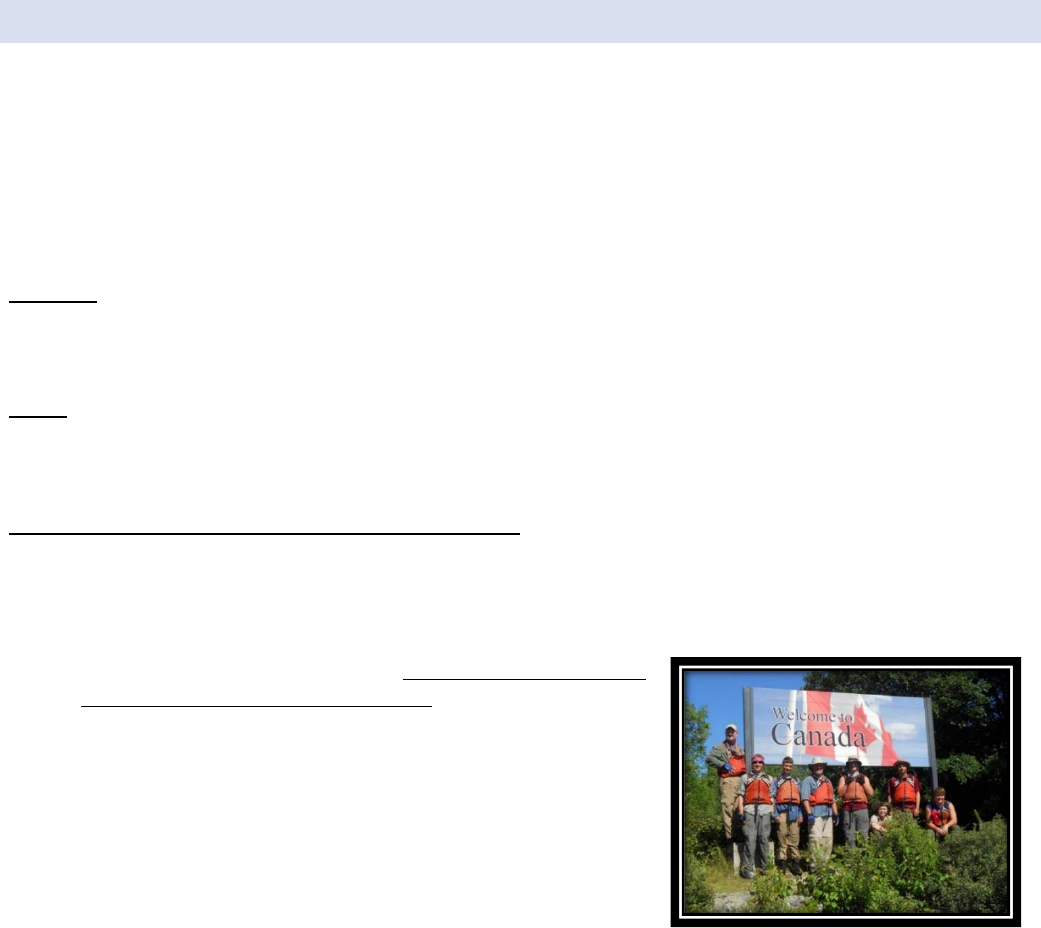
2023 Advisor’s Planning Guide Revised 11/8/22 Page 19
• Crews travelling out of Ely will pay their permit fees at Prairie Portage upon entry. Crews will need a
credit card to charge the Quetico fees and it is recommended that you bring two just in case one does not
work at the border.
• Crews travelling out of Atikokan will pay their permit fees at the Quetico Parks office in Atikokan. Crews
will need a credit card to charge the Quetico fees and it is recommended that you bring two just in case
one does not work.
ADDITIONAL QUETICO PARKS INFORMATION
Each person entering Quetico Provincial Park from the Ely Base must have a Remote Area Border Crossing
Permit - to learn more about applying for an RABC, please visit http://cbsa-asfc.gc.ca/publications/forms-
formulaires/bsf386-eng.pdf for the most up to date RABC application and instructions. The cost for an RABC
was $30 CND per adult in 2022. Youth RABC’s have no cost, but youth are still REQUIRED to have an RABC to
cross the border. This fee is set by Canada Border Services and updated information can be found at
http://cbsa-asfc.gc.ca/prog/canpass/rabc-pfre/menu-eng.html. ALL MEMBERS OF THE CREW MUST CARRY
THEIR APPROVED RABC ON THE WATER. It is IMPOSSIBLE to make last-minute change of crew members
and leaders because of the RABC regulation.
Passports
It is imperative that every member of the crew come prepared with a Passport or Passport Card, to present to
customs officials.
NOTE: Canada has very strict guidelines regarding certain criminal violations. DUIs, Reckless Driving as well as
various other convictions can be significant obstacles in crossing the border. Persons with a criminal record
may not be granted an RABC and will therefore not be permitted to enter Canada. If you have questions,
please contact the Canadian Border Services Agency at 807.624.2162.
CROSSING THE CANADIAN BORDER IN THE WILDERNESS
Travel into Canada with a group of youth requires careful planning. The documentation required to travel outside
the US (passports, passport cards and RABC’s) may take several months to acquire. All youth age 17 and under
must have a Parental Release Form allowing them to travel internationally. This form can be found in appendix
M or on the Northern Tier website https://www.ntier.org/reservations/canoetripplanning/
• The Parental Release Form must be signed by both parents and
have both parents’ contact information. Children with special
circumstances (death of a parent, legal guardian, etc.) should
bring proof of their custody arrangement.
• The Canadian government is very concerned about the
trafficking of children across the border. They require these
documents to ensure that all children are crossing the border
with the consent of all legal guardians. While currently, the
Parental Release Form does not require notarization, rules may
change in the future to become stricter.
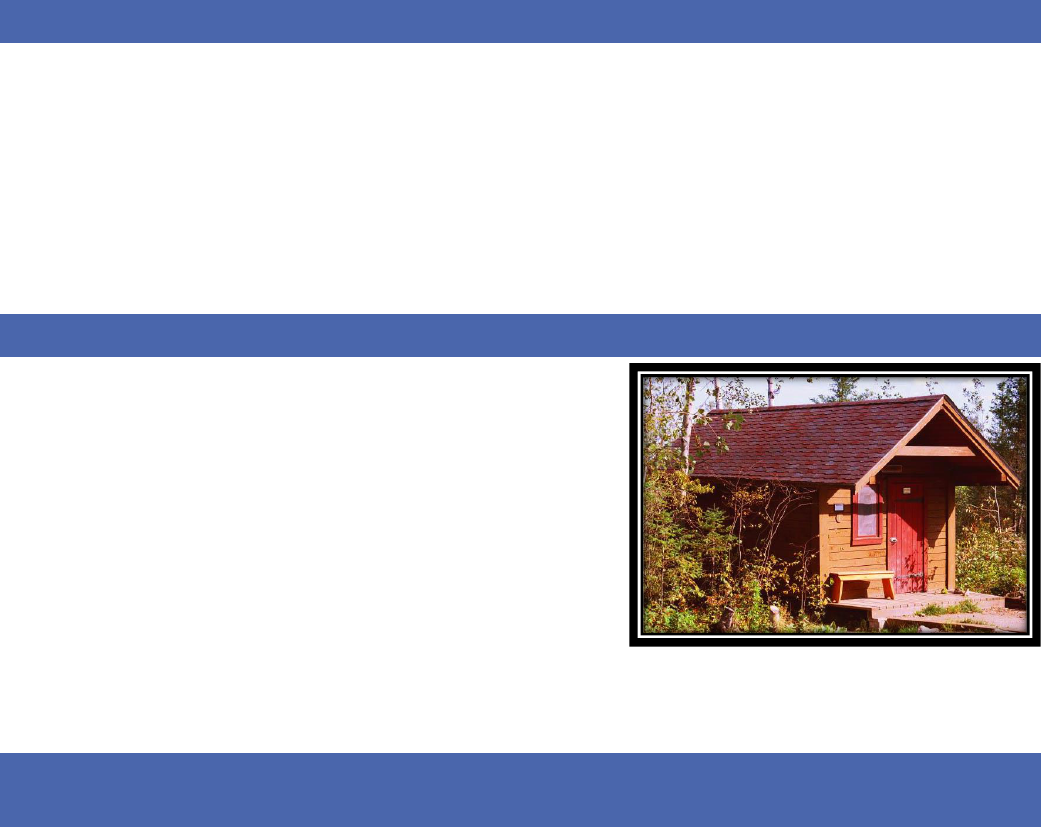
2023 Advisor’s Planning Guide Revised 11/8/22 Page 20
WHERE CAN WE STORE OUR ITEMS WHILE ON THE WATER?
For crews parking vehicles on base, Northern Tier requests that personal gear be stored in the locked vehicle. For
crews that are dropped off at base without a vehicle, each crew will be issued one locker for storing personal gear
that is not going on the water. The dimensions of the locker are 22” wide x 24” deep x 45” high. Crews will need
to bring a lock to secure their locker. Northern Tier does have locks available for purchase in the trading post.
Northern Tier suggests packing in duffel bags for an easier fit in the locker. Please note that these lockers are NOT
available for crews that have personal vehicles that will be staying in the base parking lot during their trip. If this is
the case for your crew, please plan on locking your non-trail gear in your vehicle. A lock box is available for all
crews to store keys, wallets and other valuables.
WHERE DO WE SLEEP ON BASE? SHOWER? DO LAUNDRY?
The night you arrive at Northern Tier and the night before you
return home, you will be sleeping on base. Each crew will be
assigned either a rustic Northwoods cabin or a spacious outfitter
tent. Each cabin is outfitted with 8 beds and/or cots. Crews with
members of different genders will be assigned different cabins.
There is a shower building with toilet facilities. Crews are
encouraged to wait to take a shower or sauna until the afternoon
they return from their trip in order to save on water resources.
Plus, nothing attracts mosquitoes better than a freshly bathed
person.
Northern Tier does NOT have laundry facilities available. Please come prepared with clean clothes to change into
after getting off the water. Uniforms are encouraged for the evening programs.
HOW DO WE STAY IN TOUCH WITH OUR FAMILY AND FRIENDS WHILE WE’RE AT NOTHERN
TIER?
Remember that you will be embarking on a Wilderness Canoe Trek. Crews are strongly encouraged to leave
connections to the urban world on base when out on the trail. Cell phones are discouraged while in the
wilderness. Northern Tier provides a reliable means of emergency communication to each crew. Please leave
your cell phones behind.
While on base, limited cell phone coverage exists and some service providers are better than others. Due to the
remote location of the bases, we cannot guarantee any cell phone coverage. Similarly, the bases have limited
internet connectivity available to crews. Our internet bandwidth is extremely limited as we are quite literally at
the end of the road. Because of this, our internet connection is reserved solely for our business operations. This
makes the necessity of completing all E-Certifications ahead of time and bringing paper documentation
IMPERATIVE.
If there is an emergency at home while you’re on trail, Northern Tier may be called at 218.365.4811 and we will
get the message to you as soon as we are able. Please note that this means we will not be able to get the message
to you until after you get off the water. We do not maintain regular contact with our crews. Remember, you’re in
the wilderness. Enjoy it!
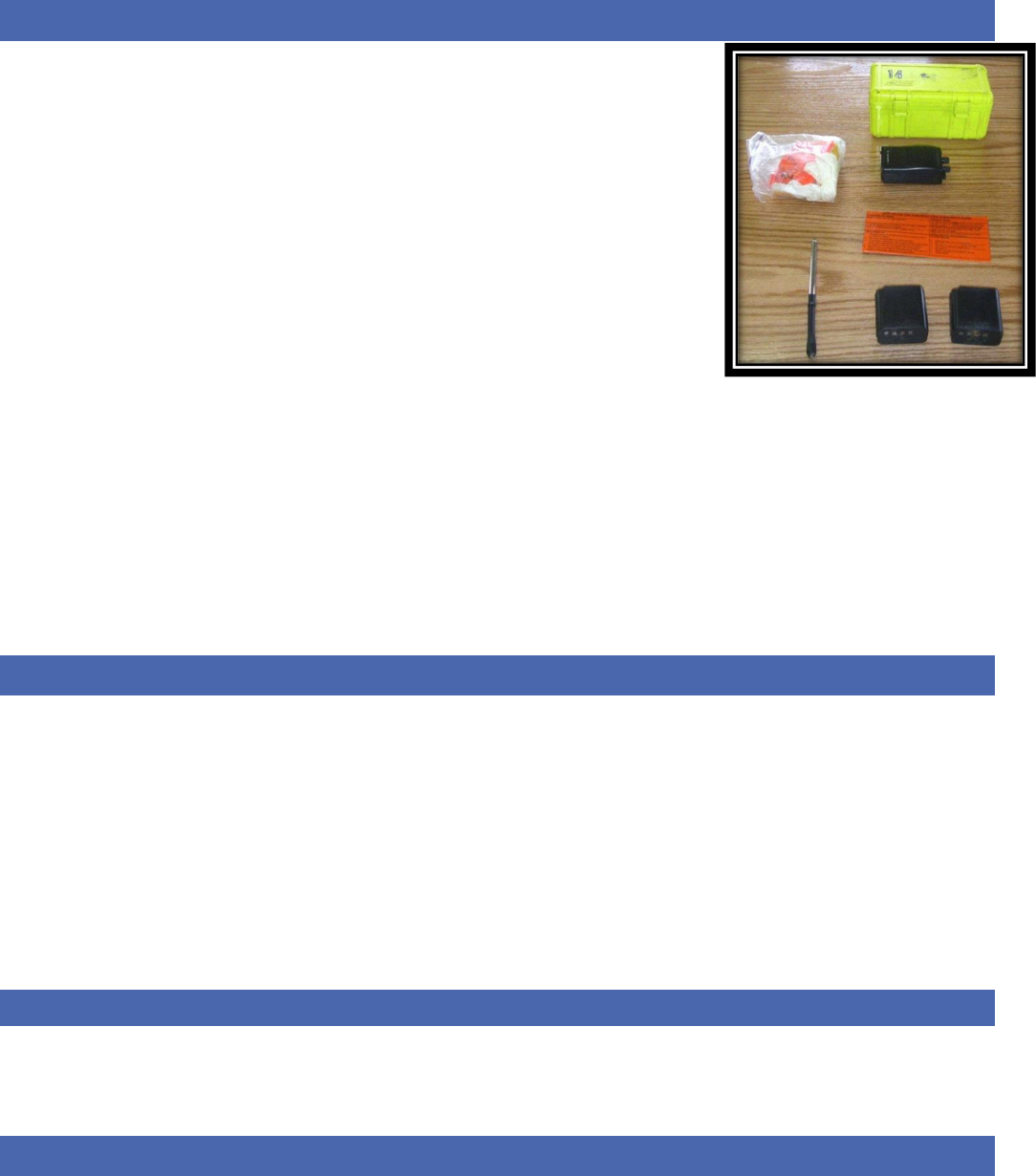
2023 Advisor’s Planning Guide Revised 11/8/22 Page 21
WHAT IF THERE IS AN EMERGENCY WHILE ON THE TRAIL?
Before we discuss emergency communications, it is important to note that
Northern Tier treks are true High Adventure experiences and your crew will be in
a vast wilderness area. Northern Tier does NOT maintain regular communication
with our crews as it is not necessary and is a drain on resources. If an emergency
does happen while on the trail, your Interpreter should immediately contact the
base and our management team will work with the Interpreter and Crew to
determine the best possible solution.
All Northern Tier crews are issued either an Emergency Radio or a Satellite
Phone, depending on their route. Your Interpreter is trained in the operation of
these devices and will in turn train your crew. Unless otherwise incapacitated,
your Interpreter is solely responsible for any communication with the base.
Northern Tier has an amazing safety record and we rarely have to evacuate
someone. When we do have to make that decision, please realize that evacuations can take several hours and
potentially multiple days as our primary method of evacuation is by canoe. While float planes are a possibility, the
use of them is considered high-risk and therefore they are only used for exceptional emergencies(or Bissett Crews).
Also, please note that float planes are not always an immediate option. Even in cases where it is determined a
float plane must be utilized it may still be several hours before the evacuation can occur depending on weather
and time of day. This is why it is absolutely imperative that every crew have an advisor certified in Wilderness First
Aid, CPR, Weather Hazards, Safety Afloat and Safe Swim Defense AND every crew must have a WELL STOCKED
First Aid kit.
PARENT/LEGAL GUARDIAN NOTIFICATION – IN THE CASE OF INJURY OR ILLNESS
The adult crew advisors are responsible for communicating to parents any notification of illness or injury while
attending the Northern Tier High Adventure programs. There will be times when an emergency happens in the
wilderness and the adult advisor won’t be able to communicate with the parents. In this case the General
Manager or the person operating on their behalf will contact the parent.
• Contact the parent or legal guardian, noted as the emergency contact, on the participant’s medical form.
It will be noted on the incident report form with time, date and person spoken.
• A representative from the crew’s home Council will be notified with time, date and person spoken.
• If the person is transported by air, a copy of the medical form will be delivered to the hospital for parent
contact or be given to EMS by a Base staff member.
• All information will be given on an as needed basis to keep participant confidentiality.
WHAT GEAR IS NEEDED?
There is a complete checklist for you and your crew to help you ensure that you have everything you need for an
enjoyable and successful Northern Tier Trek. Most items may be purchased through the Northern Tier Trading
Post Store at https://store.ntier.org/. See appendix F for full gear list.
WHAT HAPPENS WHEN I ARRIVE AT BAS E?
The afternoon of your arrival will be busy! Please make sure that you arrive on base between 1 and 2 PM. Be
prepared for the following:
• Meet your Interpreter
• Complete your first portage! Carry personal and group gear to your crew’s assigned cabin (may be up to a
¼ mile hike). Do not pack in roller luggage, it is a rugged trail to your cabin. Pack in a backpack or duffel

2023 Advisor’s Planning Guide Revised 11/8/22 Page 22
bag. If you plan to store your gear in a Northern Tier locker, make sure you use a frameless pack, so they
collapse into the locker.
• Medical Screening of everyone.
• Crew Check In – see Appendix B
• Gear and food outfitting
• Route Planning
• An Interpreter led shake-down of group and personal gear
• Dinner at 5:30 PM
• Orientation presentation
• Visit the Trading Post
Check-in will be completed the afternoon of your arrival. Crews arriving after 2:00 may not be able to complete
these tasks and will be delayed in getting on the water the next day. We cannot accommodate early arrivals at
Northern Tier, if your crew arrives before the 1:00 check in time, we ask that you wait in the parking lot and your
staff will be there by 1:00 to greet you.
Breakfast will be served at 7:15 AM the next morning. Your Interpreter will lead you through any additional
preparations which will include:
• Canoe Check Out
• Food Check Out
• Final Gear Check Out
• Store personal items in lockers or vehicles
• The efficient crew will be on water by 10:00 am.
TRADING POST (RETAIL STORE)
Northern Tier’s Trading Post sells a large supply of gear, souvenirs and snacks.
Atikokan and Bissett bases only accept Canadian cash, Visa, or Mastercard so plan accordingly to make sure that
nobody misses out. We encourage all participants traveling to Canada contact your bank to place a travel advisory
to reduce the risk of your bank flagging transactions once you enter Canada.
Each participant spends on average $150 at the Trading Post. For more information go to store.ntier.org.
WHAT ABOUT OUR FOOD? WHAT DO WE EAT?
Your crew will eat four meals on base. The day you arrive, you will eat dinner in our dining hall. Uniforms are
encouraged for the dinner meal. The next morning before you hit the water, breakfast will be served in the dining
hall. You should plan on wearing your trail clothes to breakfast, in order to expedite your departure on the trail.
After you get off the water, you will again eat dinner in the dining hall and breakfast the morning before you
leave. (Bissett Crews typically eat lunch on base upon returning from the wilderness)
While on the water your crew will partake in some of the best trail food in the business. Our commissary is
stocked according to an expertly crafted menu. Your Interpreter spends the morning before you arrive at base
packing your food. After you arrive, your Interpreter will go through the trail food with you and explain what is
included. This also allows you and the Interpreter to double check and make sure everything is packed. You will
pick up the trail food in the morning before hitting the water. Don’t forget your fresh meals!

2023 Advisor’s Planning Guide Revised 11/8/22 Page 23
WHAT PARTICIPANTS WITH SPECIAL DIET NEEDS?
We make every effort to accommodate special diet requests. The key to success is communication – the staff at
Northern Tier needs to know about Special Diet needs and needs to know well in advance of the trip. When
entering your roster information it is important that the special diet information is accurate and correct. Our food
service staff will communicate directly with the individual or individual’s parents regarding those needs. It is
important that you provide us with a direct email and phone number for that individual, so we can communicate
with them.
For those requests we can accommodate, there will be an additional $75 fee to provide the special food. Most
substituations are significantly more expensive and Northern Tier does need to offset that increase in food cost.
Individuals are welcome to provide their own food and not pay this fee. As previously stated, we make every
effort to accommodate special diet requests, but in some situations, it is not possible. In those situations, we will
let the individuals know what we can provide and ask them to supplement additional food on their own.
Menus and further information can be found on the Northern Tier website: ntier.org/resources/food
WHAT IS MEDICAL SERVICE LIKE IN THE AREA?
Each of the communities that Northern Tier operates in have access to medical services, however the remote
nature of expedition trekking brings with it challenges when it comes to accessing care quickly. Northern Tier Staff
is familiar with the local hospitals, but it is imperative that all participants and staff exercise caution and be
mindful of risks throughout their trip as well as always traveling with a fully stocked first aid kit and at least one
adult trained in Wilderness First Aid and CPR or above.
Ely
The Ely Community hospital is well versed in common injuries and illnesses experienced in canoe country.
Atikokan and Bissett
The nearest hospitals to Atikokan and Bissett are small rural health centers that are used very rarely. They do not
accept U.S. Insurance, but do provide paperwork for you to make a claim upon your return home. They expect
payment in cash or credit card.

2023 Advisor’s Planning Guide Revised 11/8/22 Page 24
Northern Tier 2022
APPENDIX AND IMPORTANT DOCUMENTS

2023 Advisor’s Planning Guide Revised 11/8/22 Page 25
APPENDIX A
NORTHERN TIER INDVIDUAL PROGRAMS
ORDER OF THE ARROW: WILDERNESS VOYAGE
The Ely base is also host to the award-winning Order of the Arrow Program for 16-20 year old individual Scouts,
the OA Wilderness Voyage. The program lasts two weeks featuring a service week of strenuous trail work for the
US Forest Service or the Ontario Ministry of Natural Resources and a second week of paddling. The program
emphasizes leadership, cheerful service and character development. For more information visit our website.
FOREST CORPS
Based off of the highly successful Order of the Arrow program, Forest Corps is a coeducational wilderness
experience focused on conservation and leadership development. The program features a week of wilderness
volunteer work within the BWCAW followed by a week of canoe tripping. Participants are young men and women
between the ages of 14-20. For more information visit our website.
LONE VOYAGE
The Lone Voyageur program allows for individual scouts or troops who cannot reach the minimum number of
scouts required for a trip to meet each other and form their own crew. These 6 day trips are offered throughout
the summer. For more information visit our website.
Leave No Trace- Master Educator
The five-day Master Educator Course is our most comprehensive education course. Participants are provided with
in-depth training on Leave No Trace skills and ethics through practical application during a field-based course.
Participants learn Leave No Trace techniques through a variety of methods—including discussions, scenarios,
demonstrations, and hands-on activities—throughout all five-days of the field-based course. The Master Educator
Course is also designed to prepare participants to be the best possible teachers of Leave No Trace regardless of
setting. For more information visit our website.
Wilderness First Aid
When you are faced with an injury or sudden illness in a remote location, it is essential to know what to look for
and what to do. Wilderness First Aid: Emergency Care in Remote Locations, is your comprehensive training. A
must for outdoor recreationists and those who live, work or recreate in remote locations. This 16-hour training
provides information on how to handle common injuries and illnesses when medical care is an hour or more away
and meets the minimum requirements set by the BSA for High Adventure programs. Northern Tier typically offers
WFA courses in December and April. For more information visit our website.
Wilderness First Responder
Wilderness First Responder (WFR) is the definitive course in medical training for outdoor educators, guides, SAR
team members, and others who work or play in remote areas. The curriculum is comprehensive and practical,
including all of the essential principles and skills required to assess and manage medical problems in isolated and
extreme environments. For more information visit our website.

2023 Advisor’s Planning Guide Revised 11/8/22 Page 26
Adult Canoe Treks
• Have you ever wondered what the fun is all about?
• Do you want to be able to promote the Northern Tier program to your Scouts while speaking from
experience?
• Did you attend Northern Tier as a youth and just want to do it again?
• Did you never get to attend as a youth and want the chance?
Northern Tier will be offering their traditional Wilderness Canoe Trek out of the Sommers Canoe Base in Ely, MN
for adults only on select treks in the summer season. This opportunity is open to those age 18 and older. For
more information visit our website.
Okpik Cold Weather Camping for Individuals
Learn the basics of winter camping. Crews will pack their gear onto sleds (or “pulks”) and head out into the
wilderness, spending their nights camping on the snow and ice. Scouts will learn how to set up a winter campsite,
how to build snow shelters and how to cook meals at low temperatures. In addition, they will get to try out a full
array of winter activities. Participants must be at least 14 years old or currently enrolled in 8th grade. For more
information visit our website
Cold Weather Leader Training
Northern Tier is the site of the Boy Scouts of America’s National Cold Weather Camping Development Center. Our
Cold Weather Leadership Training program combines an on-base seminar curriculum with a hands-on, on-ice
training (including two nights on the trail).
This five-day course is fun, informative and an excellent preparation for designing and leading your own troop and
council level winter camping adventures. Minimum age is 18 by arrival at Northern Tier. For more information
visit our website.
Kodiak
Kodiak is a BSA youth leadership opportunity centered around high adventure trekking. This exciting youth driven
challenge gives participants the opportunity to advance their leadership skills through the outdoor adventure
setting while completing a trek and overcoming obstacles as a group. This course takes place during Northern
Tier’s Okpik season which adds an additional layer of challenge as participants will be completing this course while
also learning about Winter camping at the BSA’s premier coldweather camping center.This 5 day course is packed
with activity that will leave scouts better prepared to lead their units back home. For more information visit our
website.

2023 Advisor’s Planning Guide Revised 11/8/22 Page 27
APPENDIX B
REQUIRED CHECK-IN DOCUMENTS
If you want your crew to be prepared for a smooth and efficient check-in, prepare all of the following documents
prior to arrival and place in a folder or binder. Bring this binder with you through the check-in process.
WILDERNESS FIRST AID AND CPR CERTIFICATION – Each Crew must present proof that one adult leader is
currently certified in CPR and one adult leader is currently certified in Wilderness First Aid.
BSA E-CERTIFICATIONS – The following trainings can be found at www.my.scouting.org. Each Crew must
present proof that at least one adult leader has training in each of the following:
o BSA Safety Afloat
o BSA Safe Swim Defense
o BSA Weather Hazards
BSA YOUTH PROTECTION – All Adult Leaders must present proof of current Youth Protection Training.
This training can be found at www.my.scouting.org.
SWIMMING CLASSIFICATION RECORD - All participants (both youth and adult) must successfully complete
the BSA Swimmers’ Test.
BSA HEALTH AND MEDICAL FORMS – All participants must submit complete and current (within 1 year)
Medical Forms and meet Height/Weight Requirements. https://www.scouting.org/health-and-
safety/ahmr/ - make sure the doctor signing the form has reviewed the Northern Tier Risk Advisory
included with the form.
PARENTAL RELEASE FORM – To be used by any crew crossing the border into Canada.
PERMIT INFORMATION – Crews travelling in the Quetico Provincial Park should bring their permit
information with them.
In addition, Crews will be asked:
o Covid Pre-Screening Questions
o If they have a complete and thorough first aid kid
o If they have arranged a float plane shuttle (Bissett Only)
o If they have any SPECIAL DEPARTURE PLANS (Early Breakfast, etc.)
o If they have any dietary restrictions

2023 Advisor’s Planning Guide Revised 11/8/22 Page 28
APPENDIX C
RECOMMENDED PHYSICAL FITNESS PLAN
To ensure safety, all participants must be physically prepared to enjoy
a rugged canoe trip. On a canoe trip, you may be paddling 10 miles a
day or more in windy conditions and may carry as much as 85 pounds
across a portage. You will be using your arms and upper body for
paddling and your back and legs for portaging. It is important that
everyone be in very good condition so that both youth and adults can
participate safely.
A regular program of physical conditioning for at least six months prior
to the trip is very strongly recommended. Plan some type of aerobic
exercise for 30 to 60 minutes a session, three to five times a week.
Jogging, running up and walking down hills or flights of stairs, and
hiking with a full pack are excellent methods of physical preparation.
How fast you can run or how far you go is not as important as regular
exercise. Other aerobic exercises such as swimming, bicycling,
stationary cycling and aerobic exercise classes can supplement your
training. Start slowly and gradually increase the duration and intensity
of your exercises.
You should also do some upper body exercises such as push-ups, weight training, pull-ups or best of all, paddling.
Remember; the first step is to check with your physician before starting any physical fitness program.
You must get a physical examination from your physician within 12 months (ideally 30 days) of your High
Adventure expedition. No other form other than the BSA Health and Medical Record will be accepted upon
arrival. The reason for this is that Northern Tier poses unique risks that your doctor needs to be aware of prior to
completing your form. Make sure your scouts take the current form to the doctor at the time of their physical.
Anyone with significant hypertension (150/95 or higher) should be treated before coming to Northern Tier to
reduce their blood-pressure and bring it as close as possible to normal (135/90). They should continue on blood-
pressure medication while participating in the expedition. Hypertension can increase the risk of angina or stroke.
While we do not operate at high altitudes participants will be carrying heavy loads over steep and rocky trails and
will experience strenuous activity in remote areas.
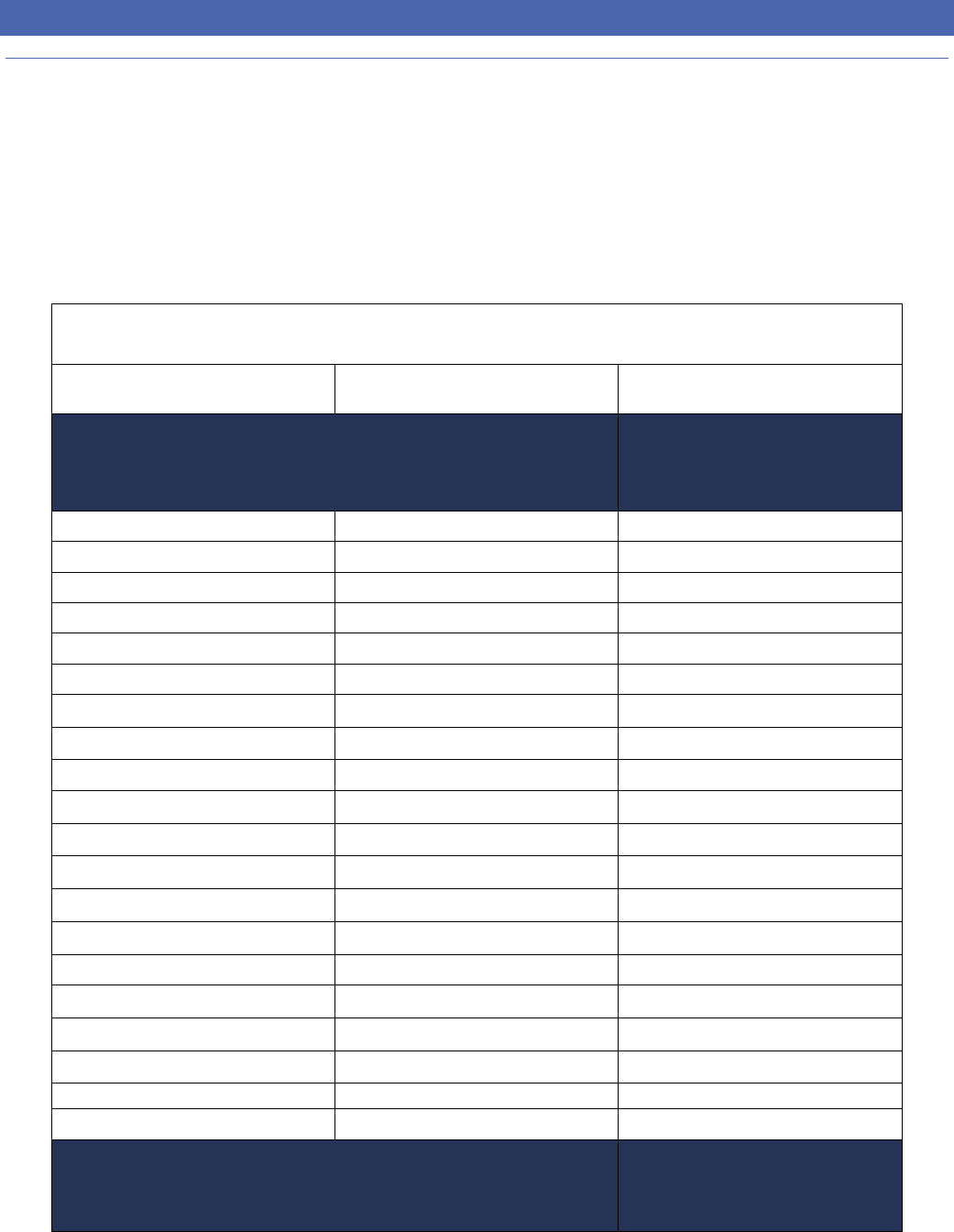
2023 Advisor’s Planning Guide Revised 11/8/22 Page 29
APPENDIX D
HEIGHT AND WEIGHT REQUIREMENTS
The following table shows the recommended weights for each height, as well as the maximum weight for that
height.
Northern Tier requires that each participant not exceed the maximum weight on the table for their height.
Northern Tier requires that you fall below the maximum (295 pounds) allowed weight for participation.
Additionally, Northern Tier strongly recommends that no participant weigh less than 100 pounds. Smaller
participants will have a very difficult time due to the strenuous nature of the trek and the heavy weight of items
to portage.
Weight-to-Height Table
Northern Tier National High Adventure Programs
Height
Recommended Weight
(pounds)
Maximum Weight (pounds)
Minimum Allowed Weight
***Participants weighing less than 100 pounds will have a very
difficult time and are discouraged from attending.
100 pounds
5’ 0”
100 – 138
166
5’ 1”
101 – 143
172
5’ 2”
104 – 148
178
5’ 3”
107 – 152
183
5’ 4”
111 – 157
189
5’ 5”
114 – 162
195
5’ 6”
118 – 167
201
5’ 7”
121 – 172
207
5’ 8”
125 – 178
214
5’ 9”
129 – 185
220
5’ 10”
132 – 188
226
5’ 11”
136 – 194
233
6’ 0”
140 – 199
239
6’ 1”
144 – 205
246
6’ 2”
148 – 210
252
6’ 3”
152 – 216
260
6’ 4”
156 – 222
267
6’ 5”
160 – 228
274
6’ 6”
164 – 234
281
6’ 7” +
170 – 240
295
Maximum Allowed Weight
***No participants weighing more than 295 pounds will be
allowed to participate.
295 pounds
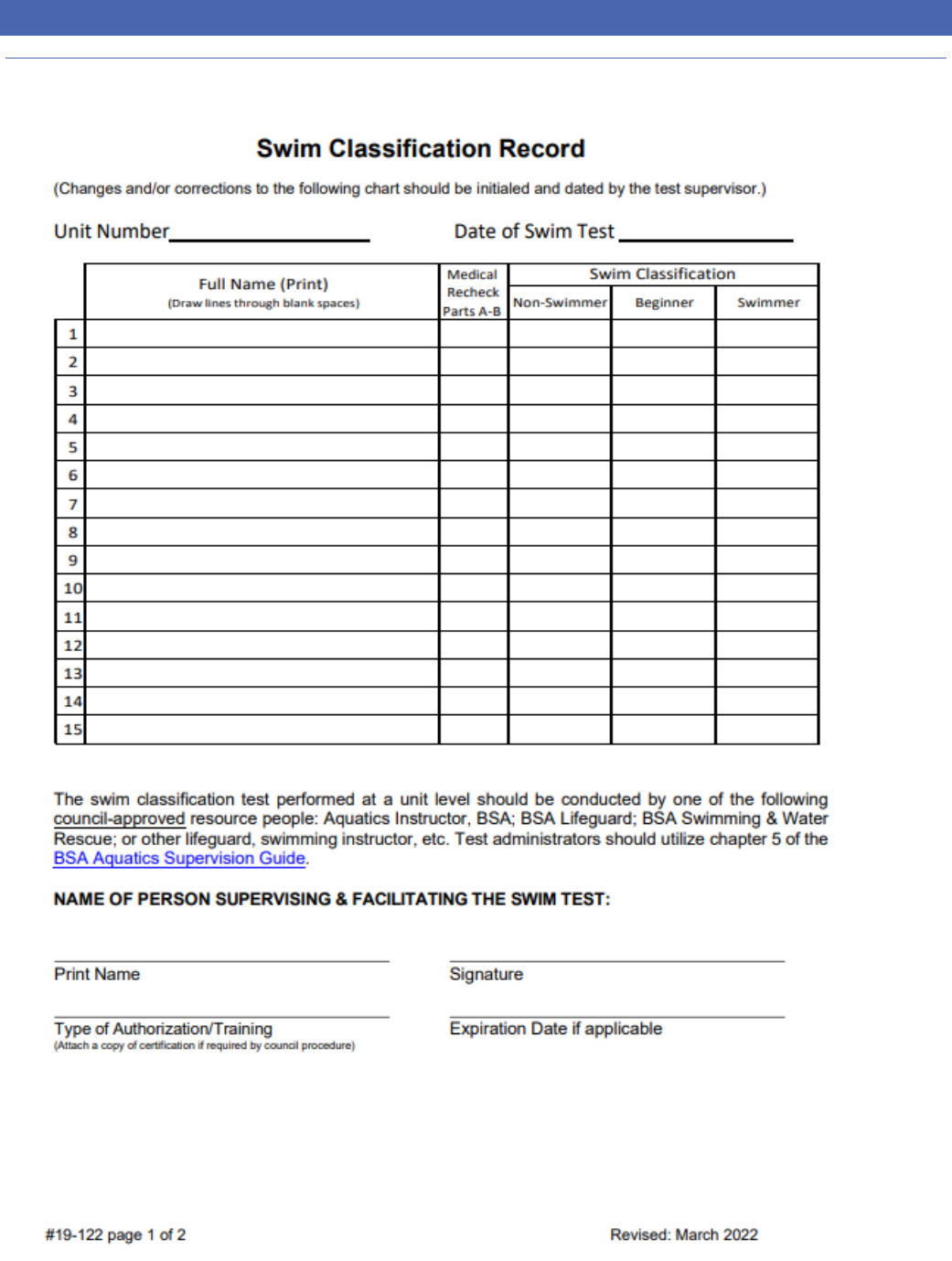
2023 Advisor’s Planning Guide Revised 11/8/22 Page 30
APPENDIX E
NORTHERN TIER HIGH ADVENTURE BASES
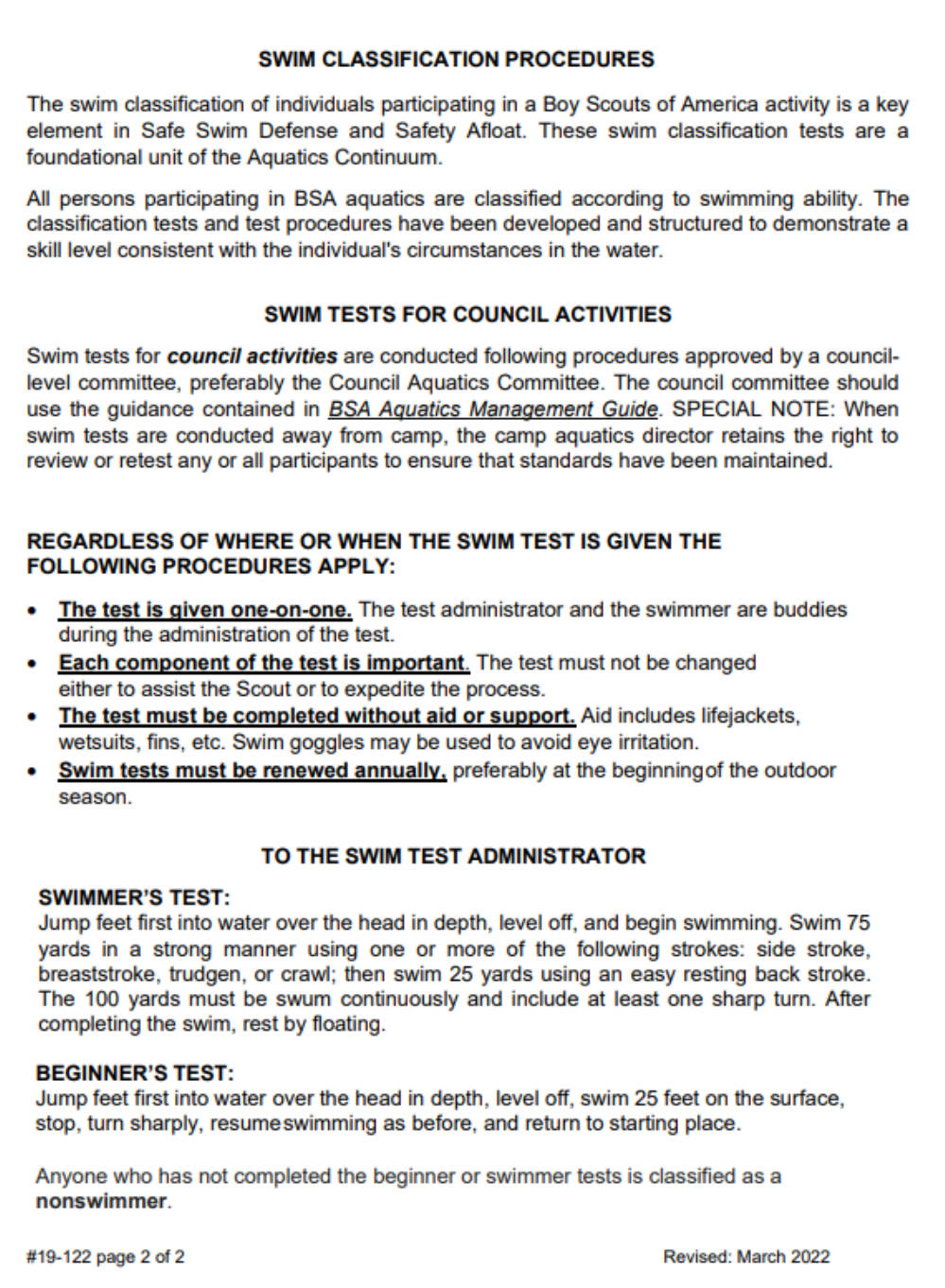
2023 Advisor’s Planning Guide Revised 11/8/22 Page 31
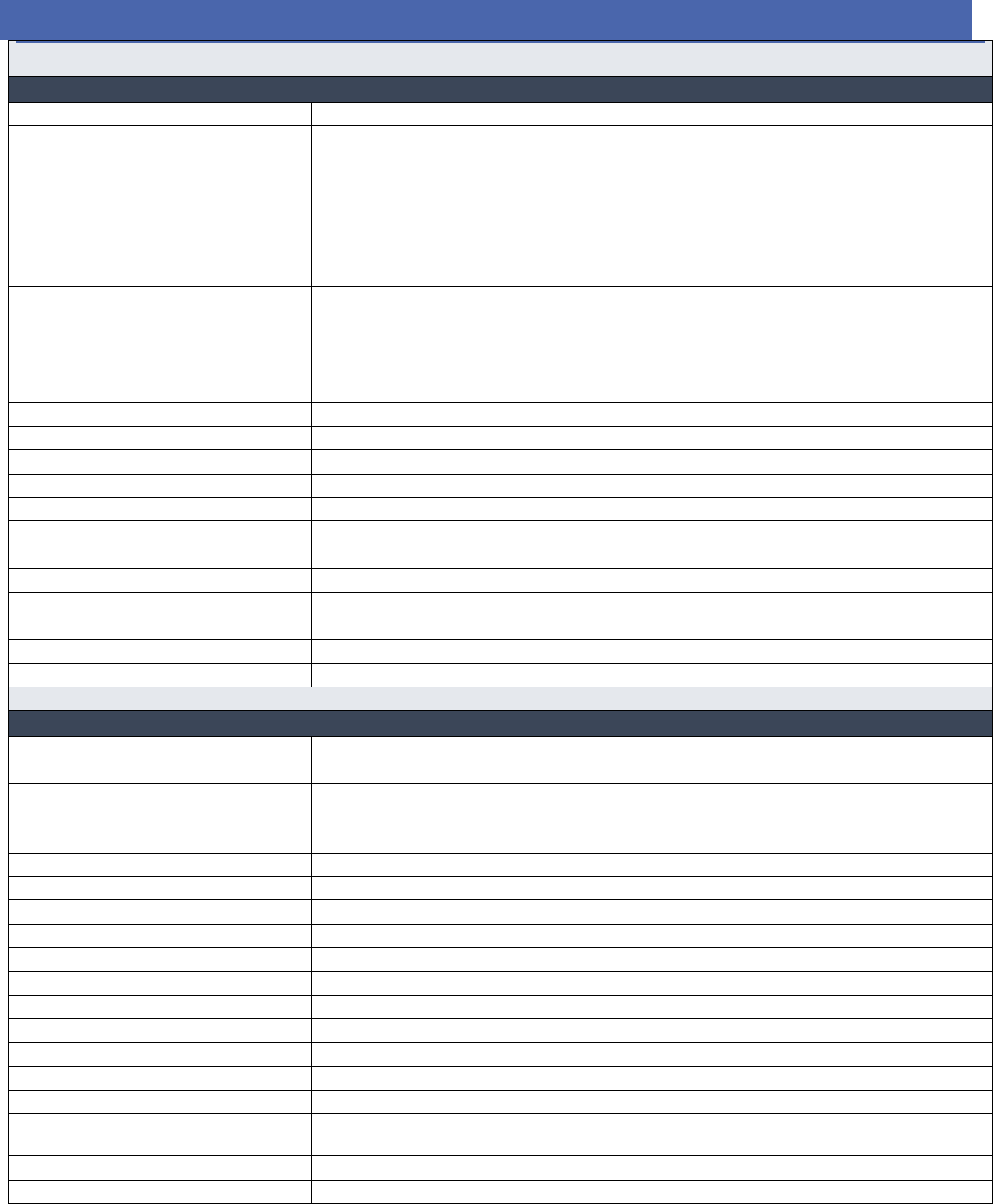
2023 Advisor’s Planning Guide Revised 11/8/22 Page 32
APPENDIX F
REQUIRED PERSONAL GEAR
Clothing
Quantity
Item
Special Notes
1
Pair of Boots**
All participants are required to wear boots that have full ankle coverage, a rugged
stitched or vulcanized sole and drainage at the instep. Boots should not be waterproof.
If you are unsure if the boots you are planning to bring meet this requirement, please
feel free to contact us prior to your arrival. Crews arriving with inadequate footwear
will be asked to purchase boots in the trading post prior to departure on water. The
health and safety of our participants is of utmost importance to us, for this reason
there are no exceptions to the boot requirement.
1
Pair of Camp Shoes
All participants are required to bring closed-toe/closed-heel camp shoes with hard
soles, such as lightweight sneakers.
1
Rain Jacket**
All participants are required to pack a quality rain jacket with a hood. Ensure that your
rain gear is waterproof, not just water resistant. Ponchos are not acceptable and are
very dangerous in the event of a capsized canoe
2
Shirts**
Long-sleeved, Lightweight
2
Pants**
Quick Dry – recommend Zip Off Legs
3
Pair of Socks**
Synthetic or Wool – NO Cotton
2
Pair of Underwear**
Recommend Synthetic, Quick Dry
1
Hat**
Broad Rimmed or Baseball Style
1
Jacket**
Lightweight Fleece
1
Hat**
Knit/Stocking Cap
1
Clean/Dry Clothes
For wearing on base and to and from Northern Tier for Travel
2
Facial Covering
2 facial coverings to wear while on base at Northern Tier.
1
Flip Flops/Sandals
For wear in the shower – these are NOT permitted on trail
1
Belt or Suspenders**
1
Uniform
BSA field or activity uniform for wear on base
REQUIRED Personal Gear
Other Personal Gear
1
Sleeping Bag
All participants should bring a sleeping bag that is compact, synthetic, lightweight and
rated to 35°F with a compression style stuff sack.
1-2
Face Masks
Face Masks are required to be worn indoors at all times and any time you are unable to
socially distance from other crews. This requirement is regardless of vaccination or
testing status.
1
Waterproof stuff sack**
25-30 Liter dry bag for clothing and other gear – this will be packed in our gear packs
1
Sleeping Pad**
Closed Cell or self-inflating foam
1-2
“Camp Towel”**
Bandanna, Buff or Synthetic Camp Towel
1
Toothbrush**
1
Mess Kit**
Plastic or Metal: 12 oz Bowl, 8-12 oz Cup/Mug, spoon/spork
1
Water Bottle**
1 Liter, wide mouthed with Carabiner Style Clip
1
Headlamp**
1
Whistle
1
Lip Balm**
1
Sunglasses**
With keeper strap
2
Prescription Glasses
IF needed with keeper strap
2
Personal Medications
If needed – 2 supplies to carry in separate locations
Personal Toiletries
1
Bathing Towel
For on base showering needs
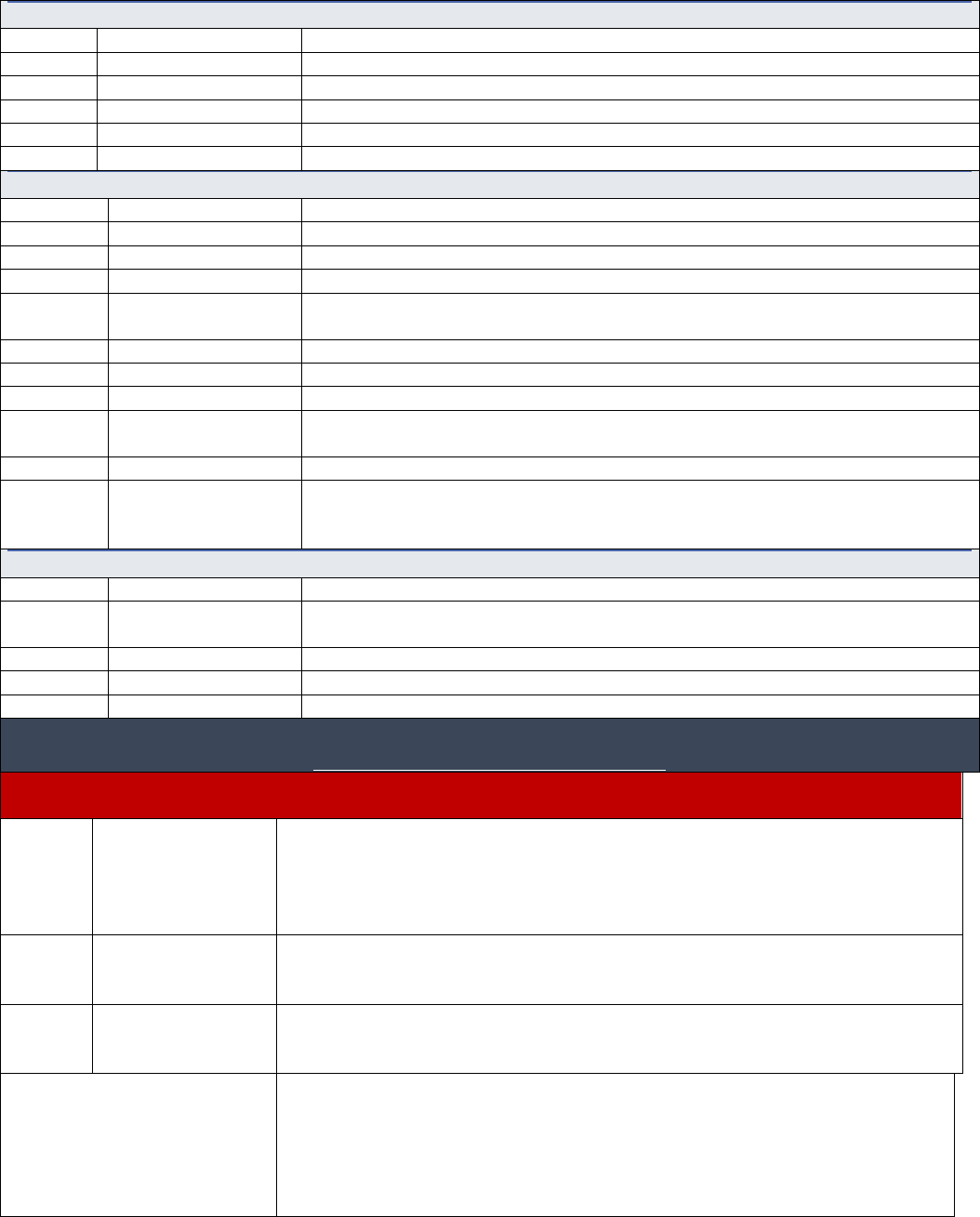
2023 Advisor’s Planning Guide Revised 11/8/22 Page 33
OPTIONAL PERSONAL GEAR
1
Camera
With extra batteries and waterproof box
1
Head Net**
For mosquitos
1
Long Underwear**
For cool nights and mornings
1
Rain Pants**
Could double as second pair of pants
1
Book **
For Reading
1
Journal**
For personal reflection
REQUIRED CREW GEAR
Quantity
Item
Special Notes
1
Small Pocket Knife**
1 Knife per Canoe (3-4 total)
1
Small Compass**
1 Compass per Canoe (3-4 total)
1
Map Case**
1 Map Case Per Canoe (3-4 total)
1
Set of Maps**
1 Set of Maps Per Canoe – Do not purchase your maps prior to arrival – we help you
pick the best set of maps for your route upon arrival.
1-2
Sunscreen**
1-2 bottles per crew – SPF 15 or greater – no aerosol cans please
1-2
Bug Repellent**
1-2 bottles per crew – High Deet content recommended – no aerosol cans please
1
Toothpaste**
1 Tube per crew is recommended
1
Medicated Foot
Powder**
1 Bottle per crew is recommended
1
Crew First Aid Kit
Complete list is outlined in Appendix H
1
Lock
If you choose to use one of our lockers to lock personal items while on trail. If you
drove your own vehicle we recommend you keep your personal gear locked in your
vehicle.
OPTIONAL CREW GEAR
Fishing Poles
Fishing Equipment is available to check out. Crews are allowed 1-2 poles per crew.
Fishing Tackle**
Limited fishing tackle is available to check out for each crew. You may want to bring
some of your favorite. Make sure it is lightweight and compact.
1
Repair Kit
Multi-tool, duct tape, small sewing kit
1
Binoculars
1
Fillet Knife**
** Items marked with a double asterisk are available to purchase at
www.northerntiertradingpost.org
What Not to Bring
SPOT Satellite
Messengers or other
Emergency Beacon
Devices
Northern Tier provides all necessary Emergency Communications devices and manages
all emergencies in conjunction with local authorities. All crews will be asked to lock any
such devices up with their valuables prior to departure on water. These devices are not
permitted on the trail.
Canoe Chairs that clip
or strap into canoes.
These damage factory canoe seats and make portaging difficult. Standard Crazy Creek
style camp chairs may be brought for use in camp sites and can double as a sleeping
pad.
Electronic Music,
Game or Video
Devices
The beautiful wilderness of Northern Minnesota, Southern Ontario and Manitoba are
the reason you’re at Northern Tier, right? Enjoy it!
Cell Phones
Northern Tier provides an emergency communication device for each crew on trail, it
is unnecessary for crews to bring cell phones for use as a communication device
(virtually no cell reception). However, we do recognize that many people use their cell
phones as their cameras and this is permitted. We would request that you leave them
in airplane mode and enjoy the Wilderness for what it is. We would still recommend
using a crew camera over a cell phone.

2023 Advisor’s Planning Guide Revised 11/8/22 Page 34
APPENDIX G
CREW FIRST AID KIT
Adhesive bandages (assorted sizes)
Knuckle and fingertip bandages
Steri strips
Moleskin/molefoam
Second skin
Gauze pads – 3” x 3”
Adhesive tape – 1” x 15’
1” or 2” roll of gauze
4” elastic bandage
Oval eye patch
Antibiotic ointment
Disposable alcohol wipes
Triangular bandage
Acetaminophen – 50 tablets
Ibuprofen tablets – 50 tablets
Antacids
Antihistamine - tablets and liquid form
Steroid cream
Anaphylaxis-Kit (if needed)
Throat lozenges
Cold caplets
Small bar soap
Lip balm
2 Thermometers
Scissors
Tweezers
Safety pins
Side cutters
Nitrile or Latex gloves
Barrier Device for Resuscitation
Sunscreen
First Aid Manual
Disposable face masks

2023 Advisor’s Planning Guide Revised 11/8/22 Page 35
APPENDIX H
GEAR PROVIDED BY NORTHERN TIER
• Portage Packs w/Liner Bags (1 for
every 3 people) (all personal gear will
be packed in the Portage Packs)
• Food Box(es) and Pack(s) w/Liner
Bag(s)
• 1 Crew Equipment Box and Pack
• Tents (2-, 4- and 5-man as needed)
• 1 Dining Fly w/Ridge Line and Stakes
• Parachute Cord
• 1 Shovel
• 1 Folding Saw
• 2 Bear Ropes and 1 Pulley/Ring
• 1 Fire Grate
• 1 5-gallon collapsible Water Bucket
• 2 Stoves, fuel bottles, fuel funnel and
fuel
• 1 Paddle/person
• 1 Life Jacket/person
• 1 Seat Cushion for middle
passenger/canoe
• 1 Emergency Radio or Satellite Phone
w/waterproof box
• 1 Utensil Kit
• 1 Slotted Spoon
• 1 Regular Spoon
• 1 Metal Spatula
• 1 Nylon Spatula
• 1 Spreader Knife
• 1 Whisk
• 1 Pair Hot Pot Pliers
• 1 Soap Kit
• Dish Soap, Sanitizer Tablets and
Scrubbies
• Hand Sanitizer
• Stove Oil
• Strike Anywhere Matches
• 1 Polar Pure bottle/canoe (for water
purification)
• Cooking Equipment:
o Cooking Pots (8, 4 and 1 quart sizes, percolator, griddle available)
o 1 Bakepacker and Baking Liner Pans
o 1 Measuring Cup
o 1 Cutting Board
• Canoes (one canoe per three people). Lightweight canoes are available in Ely and
Atikokan by reservation (extra fees apply).
• Full Trail Food Outfitting - 3 balanced meals per day and:
• Spice Kit with a wide variety of spices and seasonings available.
• Condiments
• Variety of hot and cold drink mixes
• Supplemental Baking/Cooking Items (Bannock, Fish Fry, Sugar, Popcorn)
• Toilet Tissue
• Fishing Equipment (Ely only, available on a first-come first served basis.
• GPS Units (available on a first-come first served basis)
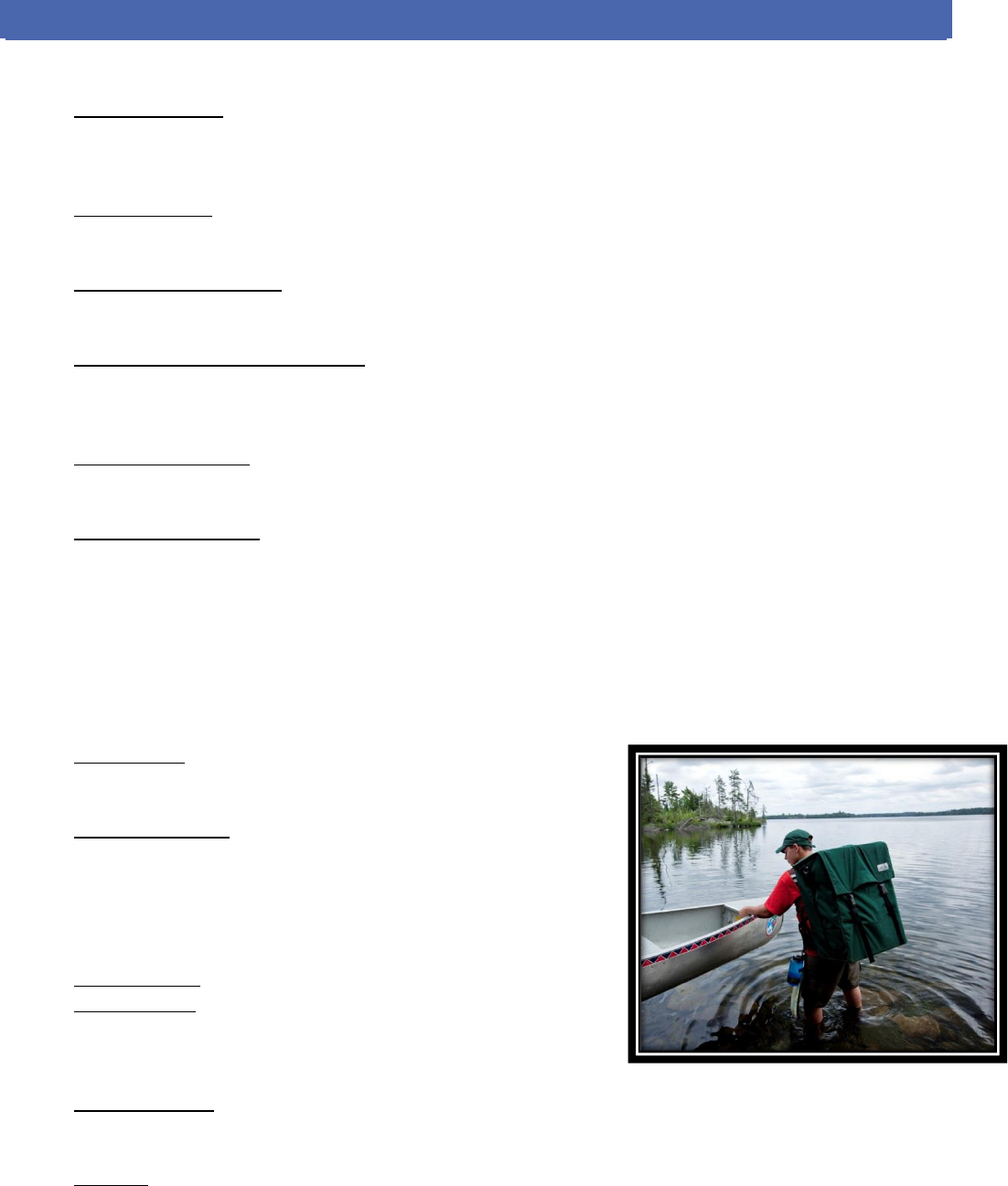
2023 Advisor’s Planning Guide Revised 11/8/22 Page 36
APPENDIX I
NORTHERN TIER POLICIES
• Secure Your Food: Bears, chipmunks, mice and other rodents are fond of trail food. Hanging your food
and ‘smellables’ at night is necessary. Remember, perfumed items (toothpaste, soaps, chapstick, etc.)
may smell like food. Your Interpreter will advise you on what to do and how to do it. Whether on the
trail or on base, do not take food into any tent or cabin.
• Respect Wildlife: We are visitors in the wilderness – please be responsible and courteous guests. Do not
bother or provoke wildlife. Animals should be enjoyed from a distance and should never be fed.
• Purify All Drinking Water: All water from all natural sources - including springs, streams and lakes must be
purified by bringing it to a rolling boil, treated with chemical purifier or filtered.
• Wash and Rinse Dishes Thoroughly: Protect the health of your crew by thoroughly washing, rinsing and
sanitizing dishes. Let dishes and utensils air dry. The dirty dishwater should be disposed of at least 200
feet behind the campsite and at least 200 feet from any water source.
• No Climbing Allowed: Rock climbing, rappelling and tree climbing are not permitted. BSA regulations
require advanced training and equipment which is not available for use on your trek.
• Swimming and Diving: All swimming and water activities must be done in accordance with the BSA Safe
Swim Defense policy. In addition, wet boots, a lifejacket and a swimsuit or shorts must be worn by all
swimmers at all times.
• Diving is prohibited at Northern Tier per the BSA Safe Swim Defense policy. Therefore, all entry into the
water must be feet first or by wading into the water. Jumping feet first into the water is allowed from
rocks or ledges no greater than five feet above the surface of the water, if the water is clear and the depth
of the water is 10-12 feet deep. Lifejackets must be worn at all times.
• Cliff Jumping: Jumping into the water from any height greater
than 5 feet above the surface of the water is prohibited.
• Whitewater Policy: The running of rapids, whitewater or
waterfalls is prohibited. All Northern Tier crews will portage
around all falls, rapids, fast water, etc. During times of unusually
high water it will be necessary to be very careful and watchful
while traveling.
• Rock Throwing: Rock throwing is prohibited.
• Solo Canoeing: There will be no solo canoeing. There must be a
minimum of two canoes at all times with 2 canoeists in each
canoe.
• Boots and Shoes: You must wear boots or shoes in all wilderness trail campsites, while canoeing,
swimming, fishing, etc. Bare feet and under-protected feet are a major cause of foot injuries.
• Tobacco: The use of tobacco is never permitted within the line of sight of youth. No smoking is permitted
in any Northern Tier building or vehicle. Each base has a single established tobacco use area.

2023 Advisor’s Planning Guide Revised 11/8/22 Page 37
• Alcohol and Drugs: Possession or use of alcoholic beverages, illegal drugs or misuse of prescribed drugs is
prohibited. Groups or individuals found in violation of this national policy of the Boy Scouts of America
will be sent home immediately, as arranged with the council office or parent.
• Firearms and Fireworks: Shooting firearms are not allowed at Northern Tier. Do not bring firearms or
archery equipment with you. Fireworks are a safety hazard and are prohibited by Northern Tier National
High Adventure. Leave them at home.
• Youth Protection Policy and Abuse: Boy Scouts of America’s Youth Protection Policies must be adhered to.
No one-on-one activities between youth and adults are allowed. The BSA two deep leader policies must
be followed. No youth and adults are allowed in the same tents. Physical, sexual or emotional abuse
(including hazing) of a camper by his or her peers or by adult leaders is unacceptable anywhere.
Reporting of abuse is the law. The local, county, state or provincial authorities as well as the BSA Council
representatives will be contacted if abuse is suspected.
• Forest Fires: Our forests are a beautiful and valuable heritage. If you spot a fire or think you have, report it
to your Interpreter, who will report it to the base director by radio or phone. Your crew should not
attempt to fight wildfires and should quickly leave the area. Because of the wilderness status, some of
the areas which have naturally occurring fires may be left to burn naturally. Other man-caused fires may
be extinguished. Trained fire fighters will monitor or extinguish the fires accordingly.
• Fires on Base: A fire on any of the Northern Tier program base facilities needs to be reported to the base
director or staff person immediately. If the fire alarm is activated, all crews are to report to the parking
area of the base facility. Each base has a fire guard plan posted.
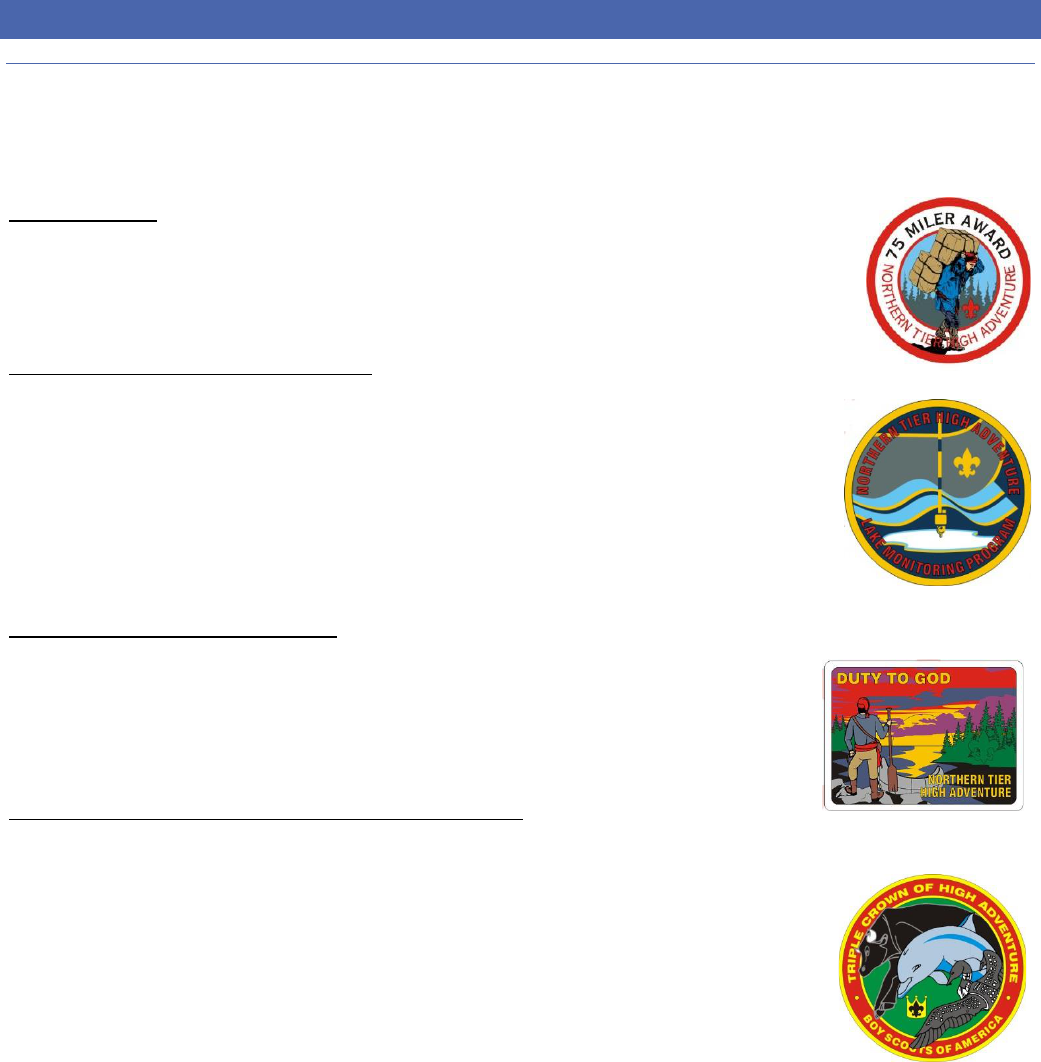
2023 Advisor’s Planning Guide Revised 11/8/22 Page 38
APPENDIX J
NORTHERN TIER AWARDS
Northern Tier offers a wide variety of patches that can be earned over the course of your trek. A brief synopsis of
each patch or program is offered here.
Mileage Awards
Northern Tier off mileage awards for subsequent miles starting at 50 miles, 25 mile
increments up to 200 miles traveled while on your trip. Patches and plaques are also available
from the Trading Post.
Northern Tier Lake Monitoring Program
Our Lake Monitoring Program provides your crew with an experience to learn about the
water quality in the lakes of Northern Minnesota and Northwestern Ontario and how it
changes. It also provides a community service opportunity for your Scouts as the data
collected is used by government agencies and scholars to monitor water clarity and
provide an assessment of suspended material in the water (often algae). Long term
monitoring provides scientists with valuable data to detect trends in water quality and
detect signs of degradation to a lake.
Northern Tier Duty To God Program
While at Northern Tier, you will encounter divine handiwork on many occasions. The
Duty to God program will help you reflect on these special moments. This popular
program requires an on base religious service, participation in at least three devotionals
while on your trek, and the leading of grace at a campfire meal.
Triple Crown and Grand Slam of High Adventure Awards
Scouts and Scouters who have participated in at least one qualifying program at three of the four national high-
adventure bases operated by the Boy Scouts of America (Northern Tier, Philmont, the
Summit, and Florida Sea Base) can earn the Triple Crown patch and certificate. To qualify,
you must earn a high-adventure program participant emblem (patch) from three of the
four national high-adventure bases.
Participants who complete a qualifying program at all four of the National High Adventure
Bases qualify for the Grand Slam of High Adventure.
Note: To earn the Triple Crown, you must complete each high adventure through the Scouting program. For
example, canoeing the Boundary Waters Canoe Area Wilderness or Quetico through another outfitter other than
Northern Tier will not qualify.

2023 Advisor’s Planning Guide Revised 11/8/22 Page 39
APPENDIX K
NORTHERN TIER HIGH ADVENTURE, BOY SCOUTS OF AMERICA
For Trips Crossing International Borders
PARENTAL RELEASE FORM
Participant’s Name: _________________________________________________________________
Date of Birth: ________________________________
Dates of Travel: From ____________________________ To ____________________________
Location: _________________________________________________________________________
Adult Leader’s Name: _______________________________________________________________
Leader’s Position: __________________________________ Unit Number: ___________________
We certify that we are the parent(s) or legal guardian(s) of the above named participant and further certify that
my child has permission to attend and participate in the Boy Scouts of America, Northern Tier National High
Adventure program under the supervision of the above named adult leader. I further certify that the above
named participant has my permission to travel in shuttle vehicles or small commercial aircraft to and/or from the
expedition location as warranted by the expedition itinerary. I understand that our local Scout Troop or venturing
Crew contracts this service.
In the event of emergency or accident, Northern Tier will notify the emergency contact listed on the “Health and
Medical Record” form if deemed necessary by Northern Tier management. We authorize Northern Tier to make
decisions regarding emergency medical care for my child while in their custody.
Signed: ____________________________________________________ Date: _________________
Name Printed: _____________________________ Phone Number: __________________________
Address: ___________________________________________ City:_________________ State: ____
Relationship to Child:________________________________________________________________
I am accompanying my child on this trip: □ Yes □ No
Signed: ____________________________________________________ Date: _________________
Name Printed: _____________________________ Phone Number: __________________________
Address: ___________________________________________ City:_________________ State: ____
Relationship to Child:________________________________________________________________
I am accompanying my child on this trip: □ Yes □ No
This form must be signed by both legal guardians. Exceptions to this requirement: In the event that there is a legal
custody arrangement whereby one parent has full legal rights please attach a copy of the court documents that
show this. In the event that one parent is deceased please attach a copy of the death certificate of the deceased
parent. If there is an informal custody arrangement whereby the legal guardian is not able to sign this form, or any
other circumstance whereby both parents are not able to sign this form please contact Northern Tier High
Adventure – Boy Scouts of America for more information.
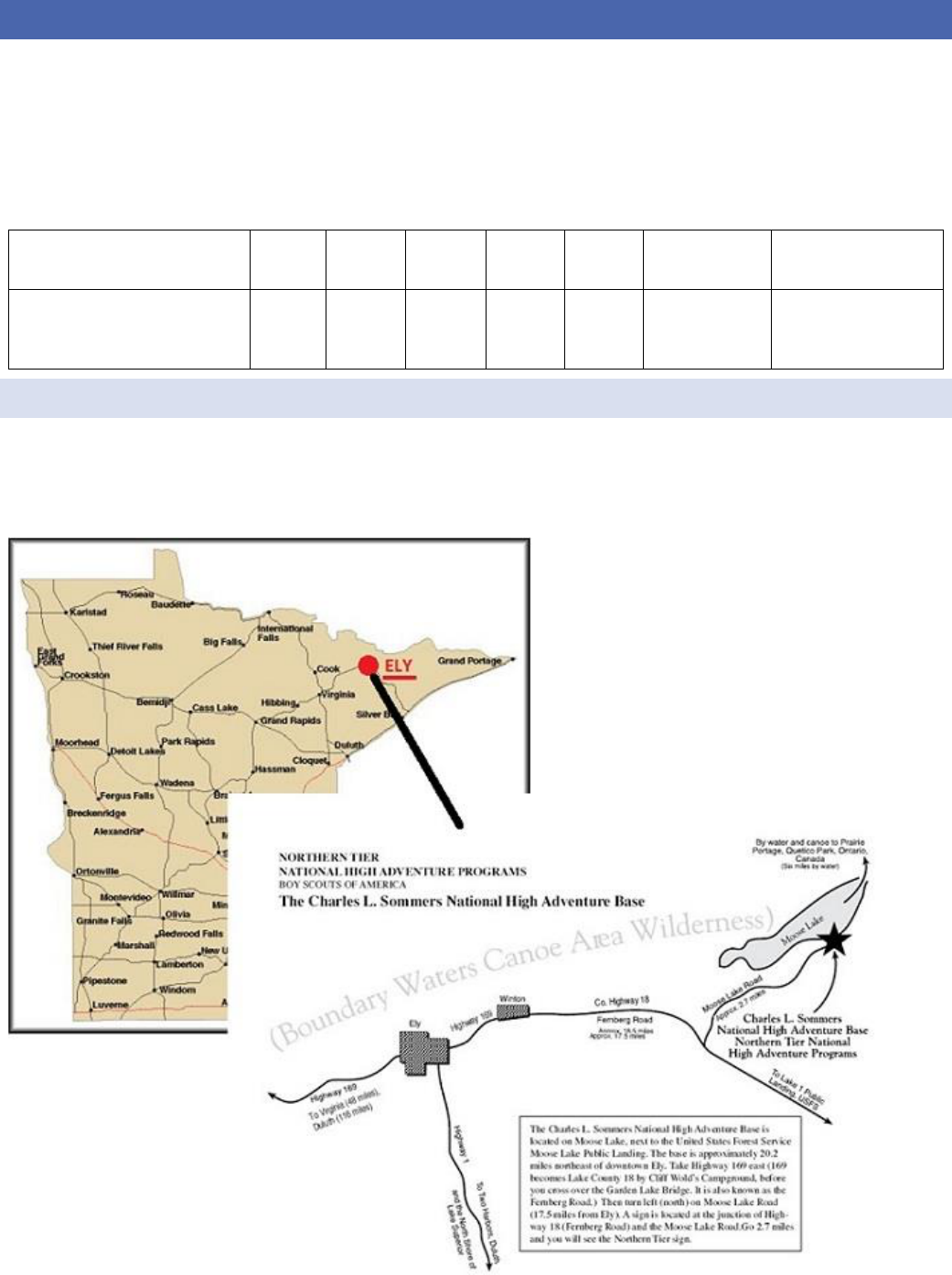
2023 Advisor’s Planning Guide Revised 11/8/22 Page 40
APPENDIX L – ARRIVAL AND DEPARTURE INFORMATION – ELY, MN
Crews should arrive at Northern Tier between 1:00 and 2:00 PM on the arrival date provided in your confirmation
details. This date is also noted in your crew number. For example, if you are crew ES060122-A, you would arrive
at Northern Tier on June 1, 2012. Lunch should be eaten enroute to the base as it will not be available for your
crew upon arrival.
Crews should plan to depart Northern Tier by 9:00 AM on the departure date provided in your confirmation
details. You will come off water the afternoon before your departure date.
Example: ES060122-A 7-Night Trip
June 1
June 2
June 3
June 4
June 5
June 6
June 7
June 8
Arrive at Northern Tier
between 1:00 and 2:00
Hit the
Trail!
On
Water
On
Water
On
Water
On
Water
Return to
Base after
1:00
Depart for Home
After Breakfast
HOW DO I GET TO THE ELY BASE?
Crews should arrive at Northern Tier between 1:00 and 2:00 pm on their first day. Lunch should be eaten
en route to the base as it will not be available for your crew upon arrival.
You are responsible for your own transportation to Northern Tier. The Ely base is located 20 miles east of
Ely, Minnesota. A printable version of the map below is available at ntier.org
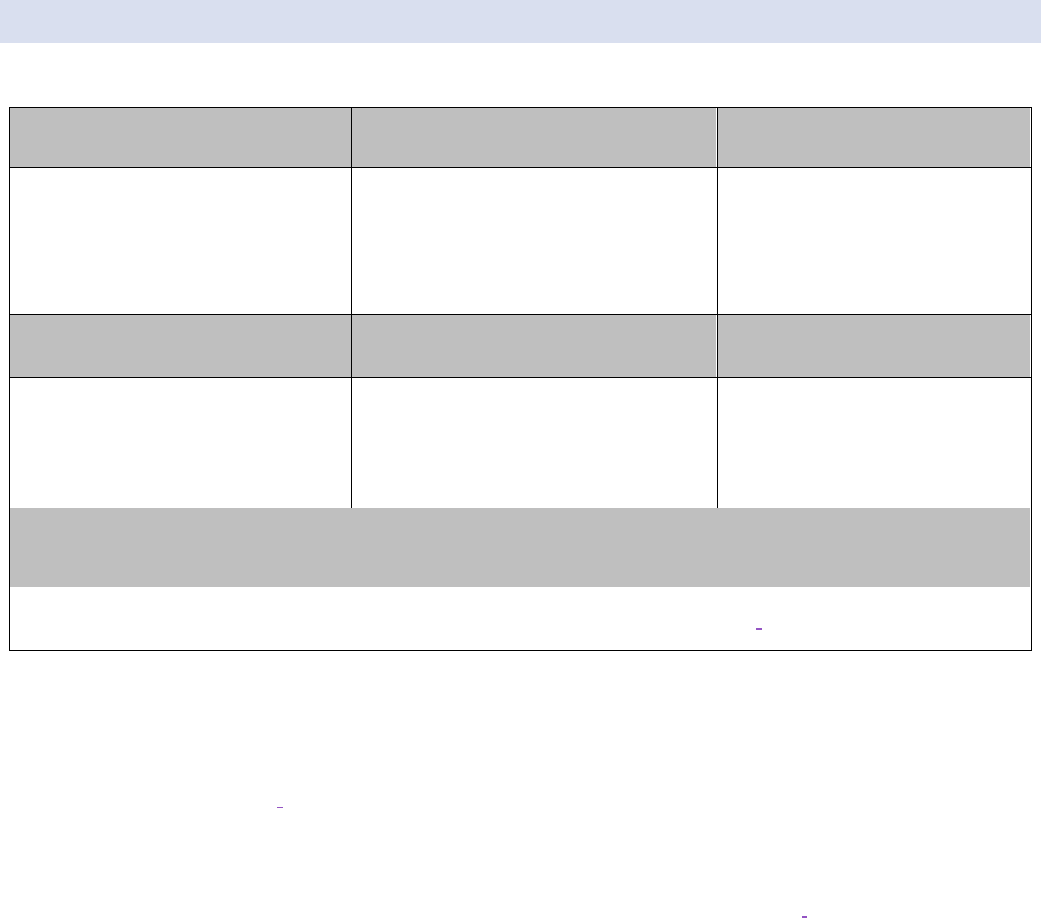
2023 Advisor’s Planning Guide Revised 11/8/22 Page 41
TRANSPORTATION OPTIONS TO ELY:
The Ely Canoe Base is 130 miles from Duluth, 270 miles from Minneapolis, 100 miles from Hibbing, and 20.2 miles
northeast of Ely. Crews using public transportation will need to arrange charter transportation to the Base.
Voyageur Charter Coach
LCS Coaches
Voyageur Bus CO/ MN Coaches
International Falls, MN 56649
Cloquet, MN 55720
Duluth, MN 55803
218.377.4343
888.743.3527
218.724.1717
877.406.9342
218.879.3391
218.724.5489
www.voyaguercharter.com
rld@frontiernet.net
www.voyageurbus.com
Shubat’s Transportation INC.
Spirit of the Wilderness
Northern Lights Van Shuttle
Service
Hibbing, MN 557546
Ely, MN 55731
Biwabik, MN 55708
888.874. 8228
218.365.3149
218-290-2722
218.262. 1042
800.950.2709
218-749-9278
www.shubat.com
www.elycanoetrips.com
Northernlights.shuttle.lodging@
gmail.com
Blue Sky Adventures
www.blueskyadventures.net/BSA/MN_No_Frills.html.
Where can I stay en route to base?
• Crews traveling through Minneapolis or Duluth may plan to overnight at Giants Ridge Ski Resort in
Biwabik, MN. Giants Ridge offers lodging and food service. Call 800.688.7669 for more information or
www.giantsridge.com.
• Spirit of the Wilderness offers bunkhouses for Scout groups. www.elycanoetrips.com
• Blue Sky Adventures offers a tour package to Northern Tier. The logistics of getting here are complicated
and Blue Sky Adventures can make the planning process much easier for your crew. For more information,
please see their website at www.blueskyadventures.net/BSA/MN_No_Frills.html.
• The International Wolf Center in Ely, MN offers overnight accommodations, with unique educational
experiences. You can find more information at www.wolf.org. Call 218-365-4695 to make reservation.
• For other lodging opportunities in the Ely area go to www.ely.org/lodging

2023 Advisor’s Planning Guide Revised 11/8/22 Page 42
What can we see along the way?
Below are some great places to check out on your way to Northern Tier. For more information please refer to the
following:
• Explore Minnesota 800.657.3700 – www.exploreminnesota.com
• Ely Chamber of Commerce 800.777.7281 – www.ely.org
• Iron Range Visitors Bureau 800.777.8497 – www.ironrange.org
Ely, MN Attractions – www.ely.org
• International Wolf Center
• North American Bear Center
• Dorothy Molter Museum
• Ely-Winton History Museum
• Ely Arts and Heritage Center
• Ely Area Veterans Memoria
• Ely Folk School
• Listening Point
Tower, MN Attractions –
• Soudan Underground Mine
• Soudan Underground Mine, Boy Scout Visit
Information
• Soudan Underground Mine Brochure
• Bois Forte Heritage Center and Cultural
Museum
Other Iron Range Attractions – www.ironrange.org
• US Hockey Hall of Fame – Eveleth, MN
• Vince Shute Wildlife Sanctuary – Orr, MN
• Minnesota Discovery Center – Chisholm, MN
• Virginia’s Mural Project – Virginia, MN
• Bob Dylan’s Childhood Home – Hibbing, MN
• The World’s Largest Hockey Stick and Puck –
Eveleth, MN
Duluth, MN Attractions – www.visitduluth.com
• The Depot
• Lake Superior Zoological Garden
• Great Lakes Aquarium
• Marine Museum at Canal Park
• Northwest Company Fur Post, Pine City, MN
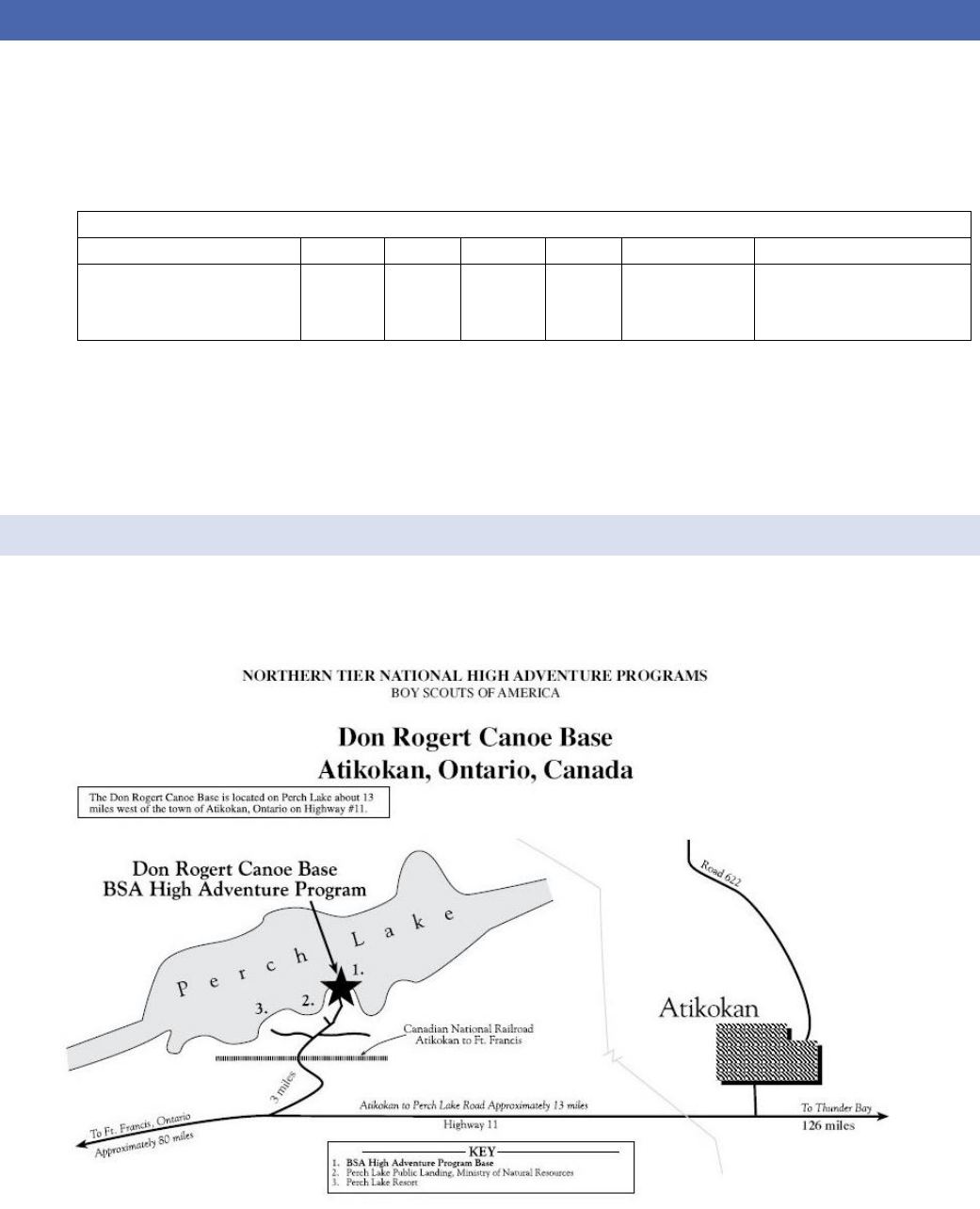
2023 Advisor’s Planning Guide Revised 11/8/22 Page 43
APPENDIX M – ARRIVAL AND DEPARTURE INFORMATION – ATIKOKAN, ON
Crews should arrive at Northern Tier between 1:00 and 2:00 PM on the arrival date provided in your confirmation
details. This date is also noted in your crew number. For example, if you are crew A060117A, you would arrive at
Northern Tier on June 1, 2017. Lunch should be eaten enroute to the base as it will not be available for your crew
upon arrival.
Crews should plan to depart Northern Tier by 9:00 AM on the departure date provided in your confirmation
details. You will come off water the afternoon before your departure date.
Example: A060117A - 6 Night Trip
June 1
June 2
June 3
June 4
June 5
June 6
June 7
Arrive at Northern Tier
between 1:00 and 2:00
Hit the
Trail!
On
Water
On
Water
On
Water
Return to
Base after
1:00
Depart for Home After
Breakfast
HOW DO I GET TO THE BASE?
You are responsible for your own transportation to Northern Tier. The Atikokan Base is located on Perch Lake,
approximately 13 miles west of Atikokan, Ontario just off of Canadian Highway 11. Please plan to arrive between
1:00 and 2:00 pm on the first day of your trip. You will need to eat lunch prior to your arrival.
TRANSPORTATION OPTIONS TO ATIKOKAN:
The towns of International Falls, Minnesota and Fort Frances, Ontario (just across the border from International
Falls) are 80 miles to the west of the Atikokan base. Thunder Bay, Ontario is 140 miles to the East of Atikokan.
The Minneapolis/St. Paul airport is 380 miles from the Atikokan base. Note: while almost all cities in the
Minnesota, Northwest Ontario, and Manitoba regions are on Central Time, the city of Thunder Bay is in the
Eastern Time Zone. Check your watch in Thunder Bay!
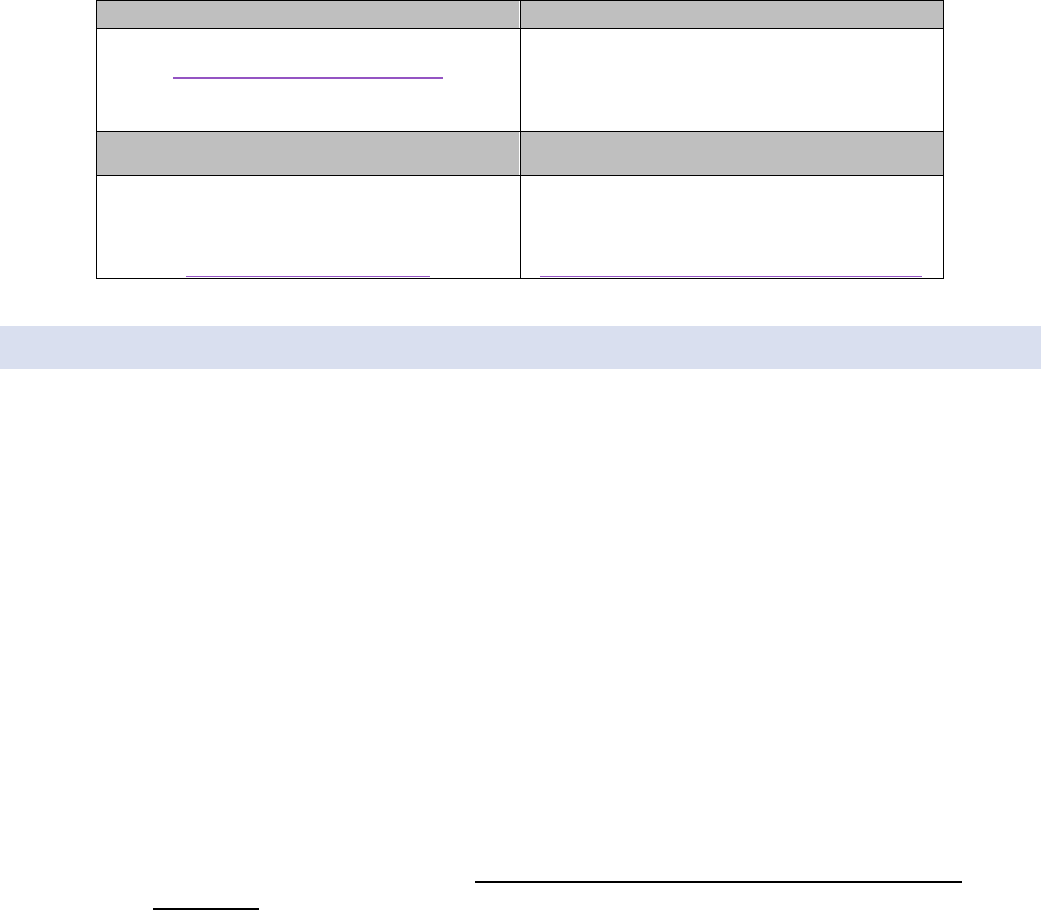
2023 Advisor’s Planning Guide Revised 11/8/22 Page 44
Crews traveling to Atikokan may choose to fly through Minneapolis, Minnesota – from there they can connect to
Duluth, MN; International Falls, MN; or Thunder Bay, Ontario. Crews traveling from the eastern US (primarily
Northeastern States) may fly through Toronto, ON to Thunder Bay, ON. Contact Air Canada, West Jet, or Delta
Airlines for details, costs and schedules.
Travel options from airports include car and van rentals or bus shuttles. Single crews may find a vehicle rental is
cheaper than a van shuttle. If you can arrange to coordinate with other crews traveling that day you can share the
cost of a bus.
Iron Range Bus Lines
North Air Van Services
Thunder Bay, Ontario
Fort Frances, Ontario
contactus@ironrangebus.com
800.465.7761
866.345.7388
807.345.7387
Voyageur Charter Coach
Northern Lights Van Shuttle Service
International Falls, MN 56649
Biwabik, MN 55708
218.377.4343
218-290-2722
877.406.9342
218-749-9278
www.voyaguercharter.com
Norther[email protected]
CROSSING THE CANDIAN BORDER
Travel into Canada with a group of youth requires careful planning. The documentation required to travel outside
the US (passports and passport cards) may take several months to acquire.
Please read the following information carefully. If you have any additional questions, please consult the US State
Department webpage on travel to Canada
(http://travel.state.gov/content/passports/english/country/canada.html) as well as the Canada Border Services
Agency website (http://www.cbsa-asfc.gc.ca/menu-eng.html).
Please follow these steps to ensure safe and conflict-free border crossings:
• All participants who are US citizens must bring an original proof of citizenship (Passport or Passport
Card) to cross the border. Passport cards cannot be used for some methods of crossing the border (i.e.,
by plane). Naturalized citizens should bring their naturalization certificate. Getting a passport can take
several months – if you need a passport, start this process well in advance of your trip.
o Non-US Citizen participants should contact a US Immigrations Office and a Canadian Customs
office to make sure their documentation is in order. Permanent non-US Citizens are advised to
bring their Alien Registration Receipt Card. Non-US Citizens must have a multiple entry Visa to
return to the United States.
• All youth age 17 and under must have a Parental Release Form allowing them to travel internationally.
This form can be found on the Northern Tier website www.ntier.org/tripplanning or in appendix M.
o The Parental Release Form must be signed by both parents and have both parents’ contact
information. Children with special circumstances (death of a parent, legal guardian, etc.) should
bring proof of their custody arrangement.
o The Canadian government is very concerned about the trafficking of children across the border.
They require these documents to ensure that all children are crossing the border with the consent
of all legal guardians. While currently, the Parental Release Form does not require notarization,
rules may change in the future.
• Anyone with a criminal record should review this Canadian Immigration website
http://www.cic.gc.ca/english/information/applications/guides/5312ETOC.asp#overview to ensure that
they will be allowed to cross the border. In some cases, individuals may apply for a waiver to have their
border crossing approved. Certain violations (ex. DUIs and Reckless Driving) can be significant obstacles in
crossing the border.

2023 Advisor’s Planning Guide Revised 11/8/22 Page 45
• All participants will need to meet the Covid-19 requirements for crossing the Canadian Border. You can
find those requirements here:
o https://travel.gc.ca/travel-covid/travel-restrictions/covid-vaccinated-travellers-entering-
canada#entry-vaccinated
WHERE CAN I STAY EN ROUTE TO THE ATIKOKAN BASE?
When you are planning flights, please consider the option of spending a night en route. While it is possible to
arrange an early flight and then drive to base, you will arrive at the base after an already long day to begin hours
of intense preparation for your wilderness trip.
Crews arriving in Northwestern Ontario prior to their scheduled arrival date should not plan on staying at base.
There are several good campgrounds in the Thunder Bay – Atikokan – Fort Frances region. Groups may stay at:
• Marr’s Perch Lake resort, is almost right across the street from the base. Convenient for crews travelling
in the day before. There is housing and a restaurant on site and is within walking distance to the base.
Phone: (807) 597-1233, marr@perchlake.on.ca, http://perchlake.on.ca/
• Grey Wolf Scout Camp outside Thunder Bay. It has been used in the past by numerous crews and have
both campsites and cabins available. For bookings contact Roberta Wolfe at 807.623.2230 or email
[email protected] or Camp Ranger William Taylor at 807.344.3338 or c[email protected].
• If traveling through Thunder Bay, you may wish to overnight at Fort William Historical Park. Old Fort
William is an historical recreation of an early 1800s fur trade fort, offering an overnight living history
program specially catered for scouting groups. Call 807.473.2344 or visit their website at www.fwhp.ca.
• If you plan on spending the night in Minnesota before driving to the Atikokan Base, consider staying at
Giant’s Ridge Ski Resort in Biwabik, MN, a resort offering lodging, food service and recreation at
reasonable rates for scouting groups 800.688.7669 or www.giantsridge.com.
What can we see along the way?
Below are some great places to check out on your way to Northern Tier. For more information please refer to the
following:
Thunder Bay Attractions – www.visitthunderbay.com
• Fort William Historic Park
• Sleeping Giant Provincial Park
• Kakabeka Falls
• Grand Portage(US side)
• Rock Climbing Boulder Bear
Places to Stay:
Fort William Historic Park
Atikokan Attractions –www.visitatikokan.com
• Atikokan Centennial Museum
• Little Falls Scenic Waterfall
• Historic Iron Mines Caland and Steep Rock
• Downtown Atikokan Walking Tour
Fort Frances Attractions
– www.fortfrances.ca/experience/tourist-
information
• Fort Frances Museum
• The Hallet
• Lookout Tower
• Rainy Lake Mermaid
• Noden Causeway
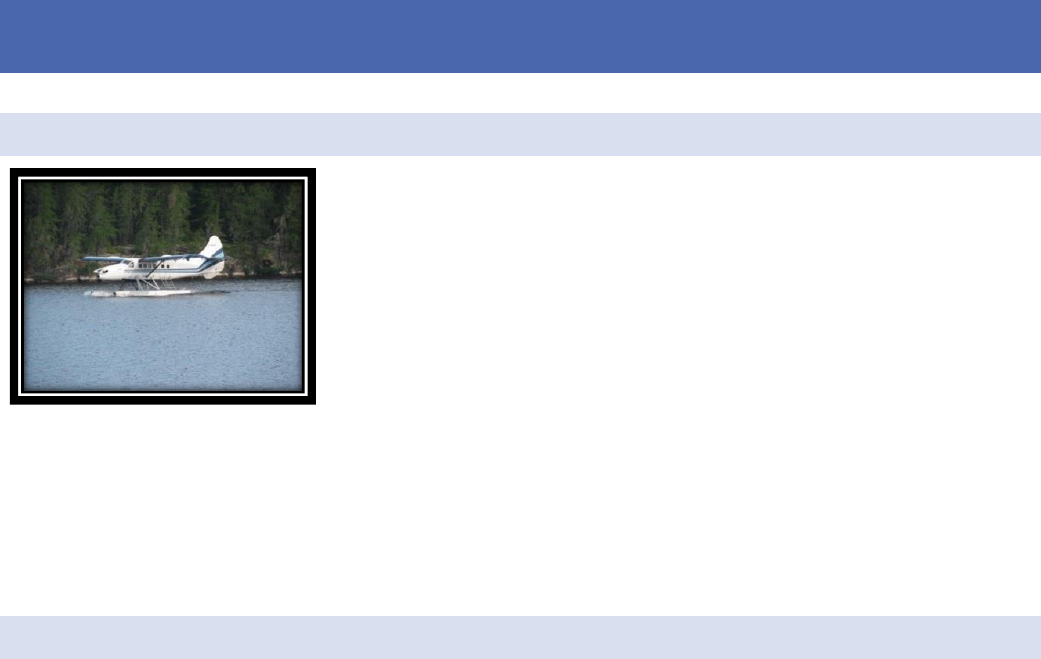
2023 Advisor’s Planning Guide Revised 11/8/22 Page 46
APPENDIX N – ARRIVAL AND DEPARTURE INFORMATION & ADDITIONAL INFORMATION –
BISSETT, MB
HOW DO I RESERVE MY BISSETT CREW’S FLOAT PLANE?
Bissett trips require a float plane shuttle to and from the wilderness canoe
cache. The cost and the scheduling of the float plane(s) is the responsibility of
the crew. The crew must also cover the cost of the flight of the interpreter.
Float Plane shuttles to the Canoe Cache are provided by Bluewater Aviation.
The round-trip cost for a flight to the canoe cache is about $294.00/person
CND in 2022. (~$235 USD) Bluewater typically offers a discount to crews who
pay in full by March 1.
Please Note: Northern Tier does not control the scheduling or promptness of your flights! Weather and other
safety concerns may require the float plane schedule to change causing your fly-in or fly-out to be delayed. This
does not happen often, but it is a possibility you should be aware of.
Crews should contact Bluewater Aviation directly to arrange their flights. The company’s year-round number is
204.367.2762. Their website is www.bluewateraviation.ca
ARRIVAL AND DEPARTURE INFORMATION- BISSETT
Crews should arrive at Northern Tier between 1:00 and 2:00 PM on the arrival date provided in your confirmation
details. This date is also noted in your crew number. For example, if you are crew BTS060122-A, you would arrive
at Northern Tier on June 1, 2022. Lunch should be eaten enroute to the base as it will not be available for your
crew upon arrival.
Crews should plan to depart Northern Tier by 9:00 AM on the departure date provided in your confirmation
details. You will come off water the day before your departure date.
The arrival time at the Bissett Base is between 1-2 pm CST on the first day of a crew’s trip. Make sure to eat lunch
in Pine Falls prior to your arrival. Crews should expect to leave after breakfast on the last day of their trip.
You are responsible for your own transportation to Northern Tier. There are many options for travel to and from
Bissett. The town of Bissett is located 150 miles (3.5 hours of driving time) northeast of Winnipeg, Manitoba.
Winnipeg is served by commercial air, rail and bus.
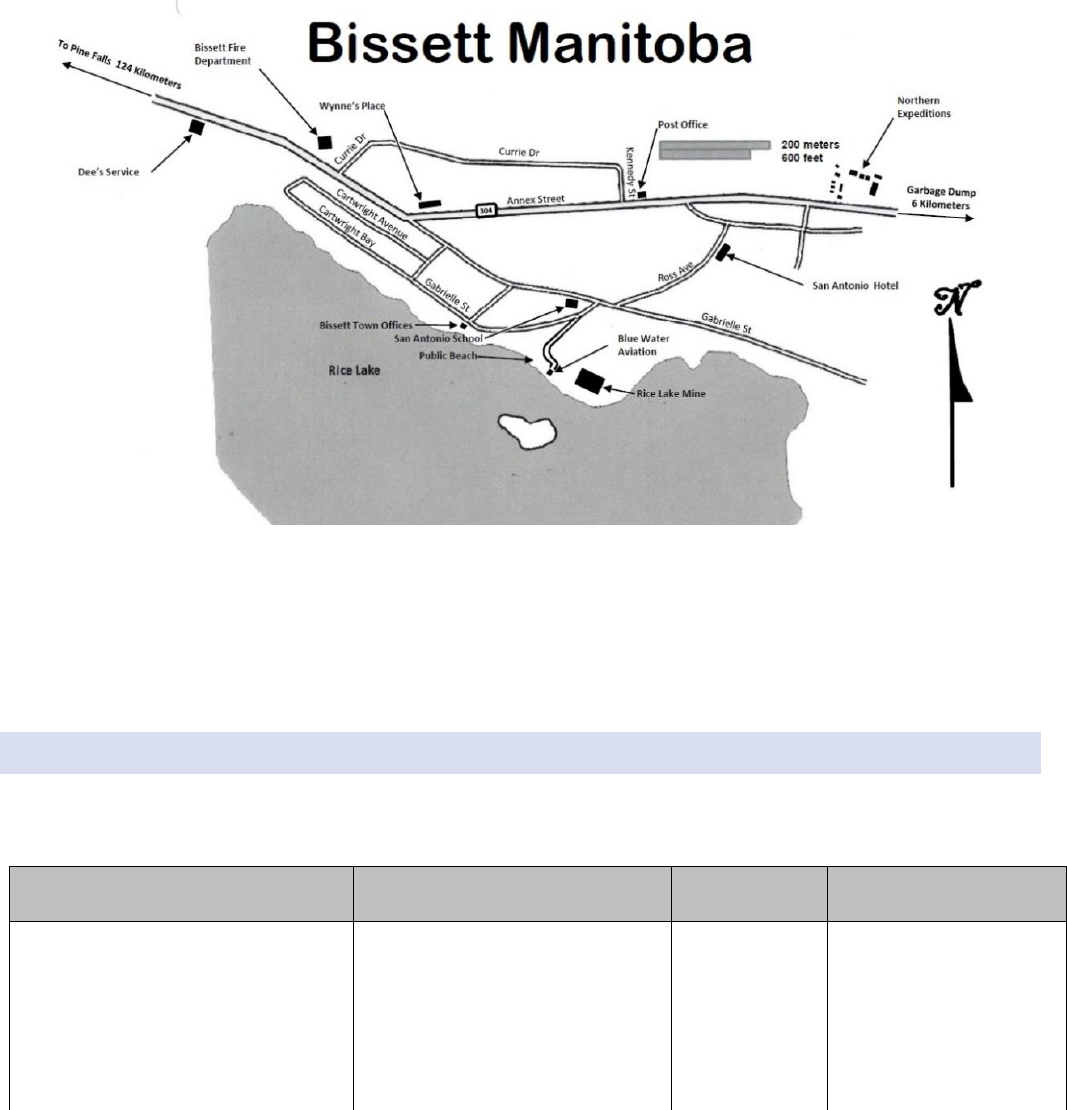
2023 Advisor’s Planning Guide Revised 11/8/22 Page 47
Most crews traveling to Bissett fly to Winnipeg. Delta Airlines has regular service to Winnipeg through
Minneapolis, Chicago and Denver. Other airlines may connect with Air Canada or West Jet in Toronto, Ontario.
If you are planning flights, please consider the option of spending a night en route. Keep in mind that while it is
possible to arrange an early flight to Winnipeg, you will arrive at the base after an already long day to begin 6
hours of intensive trip preparation. In addition, Winnipeg is a great city with a lot to see and do.
TRANSPORTATION OPTIONS TO BISSETT:
Crews arriving by public transportation will need to arrange charter transportation to Bissett. A few of the more
popular options are listed below:
Vital Transit
Northern Soul Wilderness
Adventure
Budget Rent A
Car
Five Star Bus Lines
Winnipeg, MB
Winnipeg, MB
Winnipeg
International
Airport
Winnipeg, MB
204.633.2022
866.425.9430
Winnipeg, MB
204.261.7698
s.paull@vitaltransitservice.com
204.878.3570
starfive@mts.net
adventure@northernsoul.ca
204.989.8510
Fivestarbuslines.com
What are the roads like when driving to Bissett?
Some crews (especially those in the Great Plains states) drive themselves to Bissett. Keep in mind that the roads
for the last two hours of the drive are unpaved and can be very rough.
Highway 304 is a remote gravel road, please be careful. While driving to Bissett, crews may encounter gravel
trucks and road graders that can kick up impressive clouds of dust. There are also many moose and deer in the
area, not all of whom understand the danger of fast-moving vehicles.

2023 Advisor’s Planning Guide Revised 11/8/22 Page 48
CROSSING THE CANDIAN BORDER
Travel into Canada with a group of youth requires careful planning. The documentation required to travel outside
the US (passports and passport cards) may take several months to acquire.
Please read the following information carefully. If you have any additional questions, please consult the US State
Department webpage on travel to Canada
(http://travel.state.gov/content/passports/english/country/canada.html) as well as the Canada Border Services
Agency website (http://www.cbsa-asfc.gc.ca/menu-eng.html).
Please follow these steps to ensure safe and conflict-free border crossings:
• All participants who are US citizens must bring an original proof of citizenship (Passport or Passport
Card) to cross the border. Passport cards cannot be used for some methods of crossing the border (i.e.,
by plane). Naturalized citizens should bring their naturalization certificate. Getting a passport can take
several months – if you need a passport, start this process well in advance of your trip.
o Non-US Citizen participants should contact a US Immigrations Office and a Canadian Customs
office to make sure their documentation is in order. Permanent non-US Citizens are advised to
bring their Alien Registration Receipt Card. Non-US Citizens must have a multiple entry Visa to
return to the United States.
• All youth age 17 and under must have a Parental Release Form allowing them to travel internationally.
This form can be found on the Northern Tier website www.ntier.org/tripplanning or in appendix M.
o The Parental Release Form must be signed by both parents and have both parents’ contact
information. Children with special circumstances (death of a parent, legal guardian, etc.) should
bring proof of their custody arrangement.
o The Canadian government is very concerned about the trafficking of children across the border.
They require these documents to ensure that all children are crossing the border with the consent
of all legal guardians. While currently, the Parental Release Form does not require notarization,
rules may change in the future.
• Anyone with a criminal record should review this Canadian Immigration website
http://www.cic.gc.ca/english/information/applications/guides/5312ETOC.asp#overview to ensure that
they will be allowed to cross the border. In some cases, individuals may apply for a waiver to have their
border crossing approved. Certain violations (ex. DUIs and Reckless Driving) can be significant obstacles in
crossing the border.
• All participants will need to meet the Covid-19 requirements for crossing the Canadian Border. You can
find those requirements here:
o https://travel.gc.ca/travel-covid/travel-restrictions/covid-vaccinated-travellers-entering-
canada#entry-vaccinated

2023 Advisor’s Planning Guide Revised 11/8/22 Page 49
Where can I fill up on Gas? Eat Lunch? Visit an ATM? Purchase Fishing Licenses?
There are several places to eat in Pine Falls / Powerview. Charlie Biggs, just across the Winnipeg River on Highway
304, offers a sit down lunch. There is a Subway and a grocery store (Dancyt’s) in downtown Pine Falls on Highway
11. Clarks Corner, a gas station at the corner of Highway 11 and Highway 304, has take-out Fried Chicken. They
ask that crews call ahead so they can be prepared to serve them 204.367.2238.
There is a park on the south bank of the Winnipeg River just to the North of the intersection of Highways 11 and
304. There are also campgrounds on the banks of the Manigotagan River (70 km/49 miles past Pine Falls on
Highway 304) and the English Brook (9 km/5.6 miles past Manigotagan). All are terrific places to eat a picnic lunch
and stretch the legs.
In past years, there has been a snack shack just as you get to Bissett, Cameron’s Rest n Go. They offer simple
burgers and drinks.
The last place to fill up your gas tank is in Pine Falls. There is no gas station in Bissett.
Similarly, should you need to acquire Canadian cash (the Bissett Trading Post does not accept US Currency) or use
an ATM, the Royal Bank of Canada in Pine Falls is the best place to stop. The RBC has a 24-hour ATM that accepts
some American Debit Cards. The ATM systems that it uses are posted next to the machine.
Finally, if events beyond your control cause your crew to be delayed, please call so that the Bissett Base can
accommodate for your late arrival. Over the past three years, luggage has been lost, flights have been cancelled
and cars have broken down. Nevertheless, all crews have departed for the wilderness on time. If you run into any
problems or have any questions while travelling, please contact the Northern Tier, 218.365.4811.
Where can I stay en route to Bissett?
Crews arriving in Winnipeg, Manitoba prior to their scheduled arrival date should not plan on staying at the
Bissett base. Winnipeg has many hotels at a variety of prices to choose from.
In Bissett, the only hotel is the Hotel San Antonio 204.277.5250. Please call ahead if you wish to stay here – at
many points during the summer all of the rooms will be filled with miners making it difficult to get a room.
What can we see along the way?
Below are some great places to check out on your way to Northern Tier. For more information please refer to the
following:
Winnipeg Attractions
– https://www.tourismwinnipeg.com/
• The Forks
• Canadian Museum for Human Rights
• Assiniboine Park Zoo
• Rock Climbing at Vertical Adventures
• Royal Canadian Mint
• Fun Mountain Waterslide Park
Other Manitoba Attractions
• Grand Beach on Lake Winnipeg
• Powerview-Pine Falls
• Things to do in Manitoba
